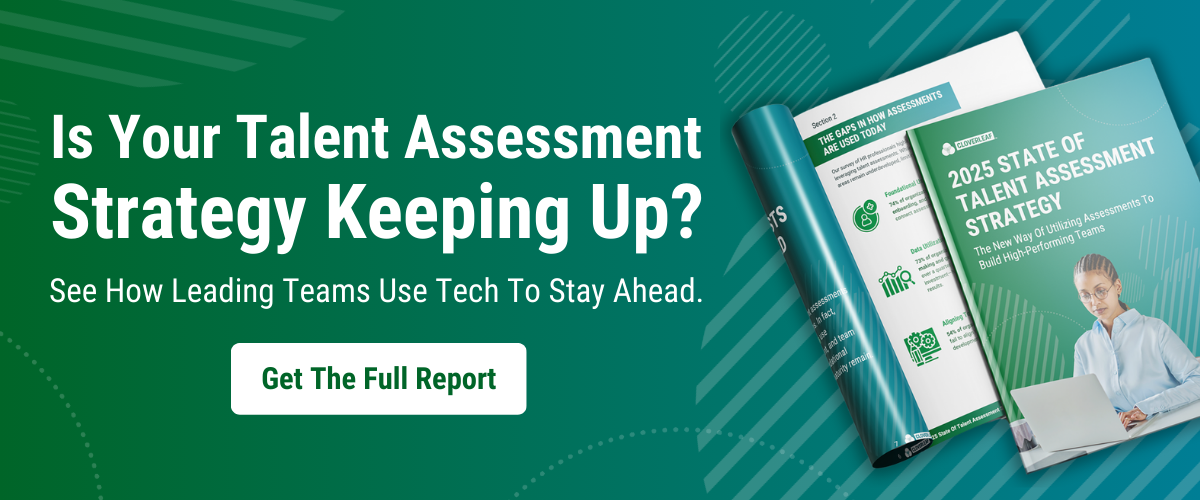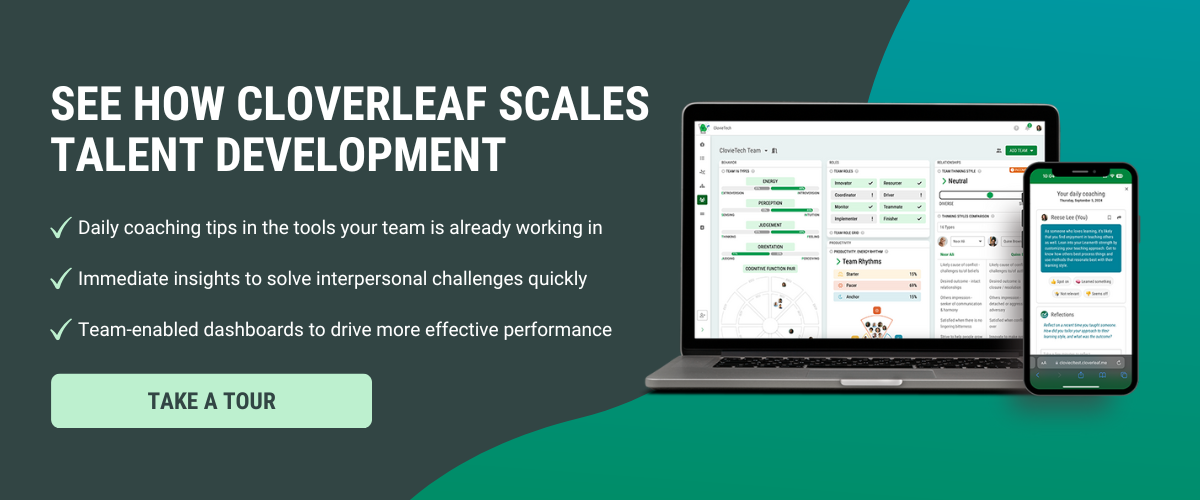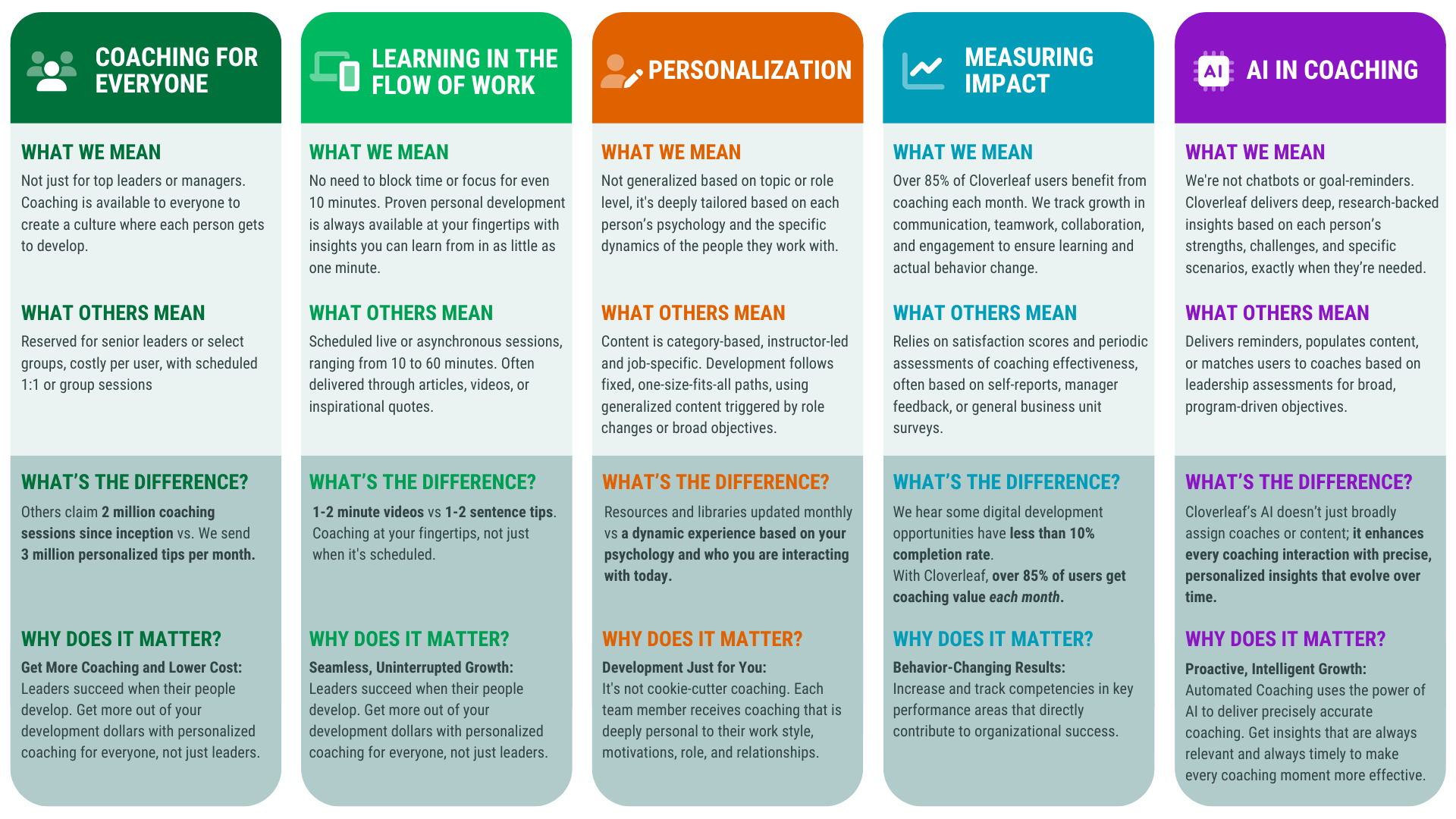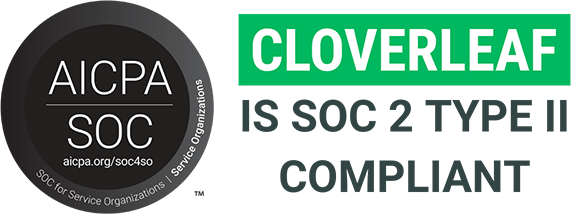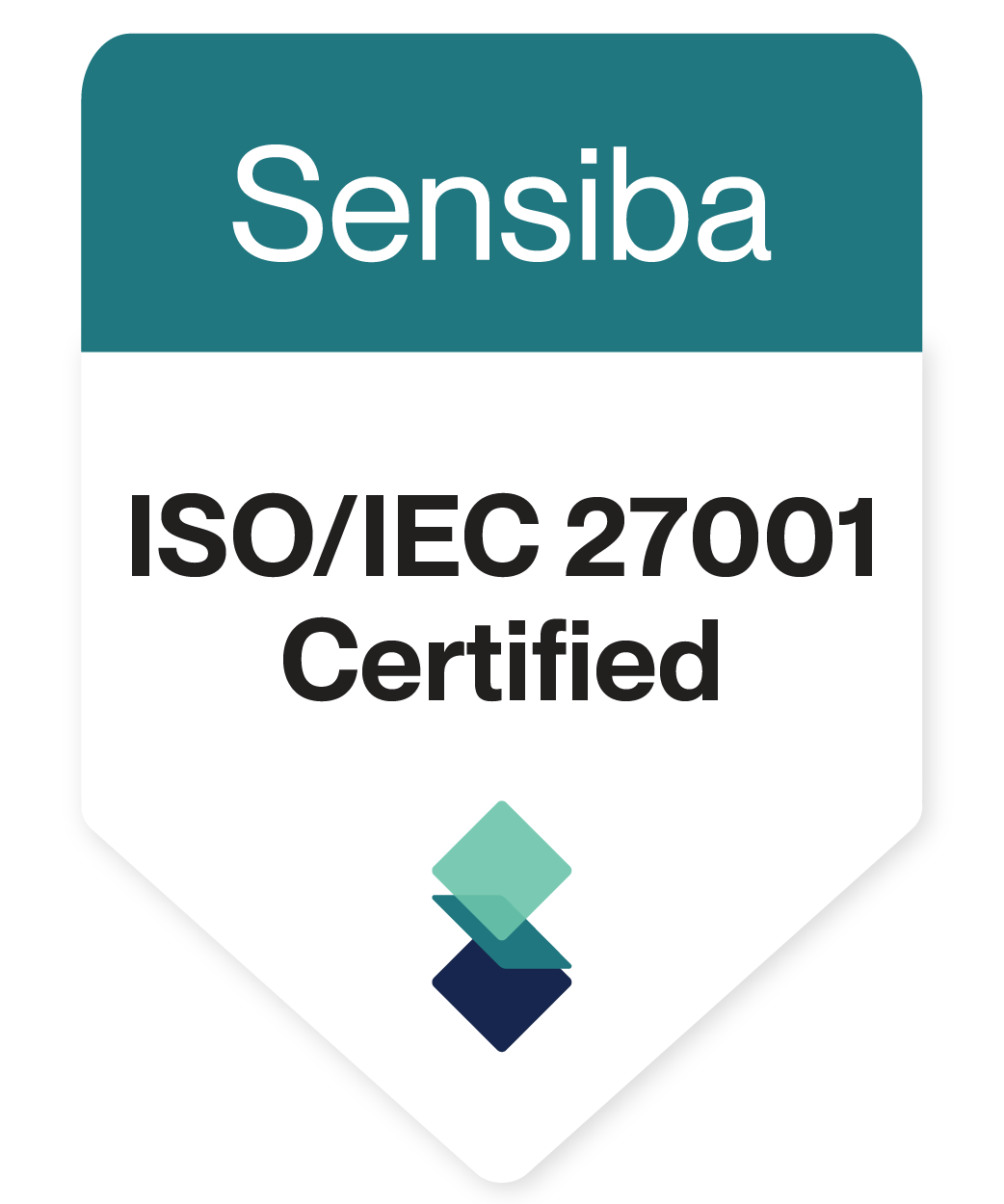New York is a city built on ambition.
Founders, executives, and team leaders here are navigating scale, speed, and complexity on a daily basis. The stakes are high, and the pressure is constant.
Great coaching isn’t a luxury in this environment. It’s a competitive edge. The best coaches don’t just help leaders think clearly. They help them lead with purpose, adapt with resilience, and grow teams that thrive under pressure.
This list highlights 35 executive coaches in NYC who are doing precisely that. They may not all be household names, but they’re trusted by the people who make things happen. Their work runs deep. Their impact is lasting.
How We Chose These Coaches in New York
This list isn’t based on follower counts or paid placements. It’s grounded in credibility.
Each coach was selected using publicly available information—no nominations, sponsorships, or submissions. We looked for:
- Demonstrated expertise: via LinkedIn, published content, media features, or thought leadership
- A clear coaching focus: from executive development to founder advising to team dynamics
- Credibility indicators: certifications, consistent client work, or peer recognition
- Professional presence: a clear message, not just a polished brand
This is not an exhaustive list. It’s a curated snapshot of coaches who are actively shaping what leadership looks like in NYC right now—and where it’s heading next.
What Makes a Standout Executive Coach in 2025
Coaching isn’t one-size-fits-all, and the best coaches don’t try to be.
What sets standout coaches apart today isn’t just training or credentials. It’s how well they adapt to the context: the company’s culture, the leader’s style, the team’s dynamics, the moment in the business. It’s not about offering advice—it’s about asking the right questions at the right time.
These are coaches who:
- Help leaders move between strategic decisions and personal growth without losing traction
- Understand the stakes—whether it’s scaling a startup, leading through change, or rebuilding trust in a team
- Bring both emotional intelligence and business acumen to the table
- Know that sustainable growth requires both clarity and accountability
Great coaching doesn’t look the same for everyone. But it does leave a mark.
Get the free guide to close your leadership development gap and build the trust, collaboration, and skills your leaders need to thrive.
THE 30 BEST EXECUTIVE COACHES IN NEW YORK
These coaches bring more than insight—they bring results. Whether they’re guiding founders through scaling pains or helping senior leaders navigate complexity, each of the professionals below has built a coaching practice that blends depth, clarity, and credibility.

Mark Strong
- Focus Areas: Corporate training, executive coaching, team building, strategic facilitation
- Certifications / Background: iPEC, Corporate CoachU, Harvard/McLean Institute of Coaching, DiSC certified
- Client Types / Industries: Creative agencies, tech firms, finance companies
- Notable Media / Content: Offers executive, life, and career coaching; widely recognized for high-energy facilitation

Erin Hilgart
- Focus Areas: Organizational development, leadership strategy, executive coaching
- Certifications / Background: Ed.D. in Adult Learning & Leadership, M.A. in Organizational Psychology (Columbia University)
- Client Types / Industries: Organizations undergoing culture transformation or leadership change
- Notable Media / Content: Published speaker and writer on leadership, learning, and development

James Turk
Focus Areas: Executive coaching, leadership development, custom learning programs
Certifications / Background: Author of The Giving Game; experienced leadership facilitator
Client Types / Industries: Tech, media, finance, healthcare, and energy
Notable Media / Content: Speaker and contributor in learning and development thought leadership

Katie Jones
Focus Areas: Talent management, team building, leadership coaching, strategic planning, project management, instructional design
Certifications / Background: MBTI® Master Practitioner; Certified DISC Facilitator; Certified in Restorative Practices; over 20 years of experience in education, including roles as a high school teacher and higher education professional
Client Types / Industries: Education, non-profit organizations, corporate sectors
Notable Media / Content: Creator of self-paced online courses such as “Type: Beyond the Letters” and “Managing Stress: Mind-Body Connections and MBTI®”

Jody Michael
Focus Areas: Executive coaching, leadership development, career coaching
Certifications / Background: Licensed clinical social worker; over 25 years of coaching experience
Client Types / Industries: Corporate executives, leaders across various industries
Notable Media / Content: Featured in The Wall Street Journal, Forbes, and CNN for expertise in leadership and career coaching

Natalie Loeb
Focus Areas: Leadership development, executive coaching, organizational culture, diversity, equity, inclusion, and belonging (DEI&B)
Certifications / Background: Master of Science in Industrial/Organizational Psychology; over 25 years of experience in professional development facilitation and executive coaching
Client Types / Industries: Mid-sized to large law firms, corporate organizations across various industries
Notable Media / Content: Appointed to the Board of the New York State Council for the Society of Human Resources Management (SHRM) in June 2024, focusing on promoting DEI&B within workplaces
Make Your Just In Time Learning More Impactful
See How High Performing Teams Use Tech To Equip Their Leaders


Joan Caruso
Focus Areas: Executive coaching, leadership assessment, organizational development
Certifications / Background: Certified executive coach with a background in psychology
Client Types / Industries: Senior executives across various industries
Notable Media / Content: Published articles on leadership effectiveness and organizational culture

Stephen Miles
Focus Areas: CEO coaching, leadership transitions, board advisory
Certifications / Background: Extensive experience in executive assessment and development
Client Types / Industries: CEOs, board members, senior executives
Notable Media / Content: Co-author of “Riding Shotgun: The Role of the COO”; featured in Harvard Business Review
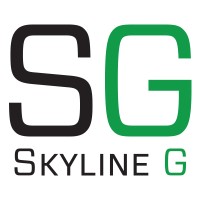
Skyline Group
Focus Areas: Executive coaching, leadership development, team performance enhancement, scalable coaching solutions
Certifications / Background: Founded in 1996, headquartered in Redwood City, California; offers a range of leadership development programs including 1:1 coaching, group coaching, and consulting services
Client Types / Industries: Serves Fortune 500 companies, startups, and organizations committed to developing exceptional leadership
Notable Media / Content: Developed the C4X coaching platform, combining integrated 360 assessments with scalable content and metrics; leadership team includes Thuy Sindell, PhD, Founder and President of the Executive Coaching Division, and Milo Sindell, MS, President of the Coaching Scaled Division

Frank Faeth
Focus Areas: Executive leadership coaching, technologist coaching, abrasive leader transformation
Certifications / Background: Extensive corporate leadership experience; certified executive coach
Client Types / Industries: Technology leaders, corporate executives
Notable Media / Content: Contributor to articles on leadership development and emotional intelligence

Maren Perry
Focus Areas: Leadership development, executive coaching, organizational enhancement
Certifications / Background: Founder and President of Arden Coaching since 2007; extensive experience in leadership strategy
Client Types / Industries: Corporate executives across various industries
Notable Media / Content: Contributor to the Arden Coaching blog on topics like feedback processing and leadership strategies

Higher Echelon
Focus Areas: Executive coaching, leadership development, organizational performance optimization, human capital solutions
Certifications / Background: Service-disabled veteran-owned small business (SDVOSB); team includes professionals with advanced degrees in Industrial/Organizational Psychology and Sport and Performance Psychology; certified by organizations such as the International Coaching Federation and the Society of Industrial Organizational Psychology
Client Types / Industries: Public and private sector clients, including small businesses, mid-sized companies, Fortune 500 corporations, government contractors, and military organizations
Notable Media / Content: Offers the Resilient and Adaptable Leadership Program; provides executive coaching services in New York City and Washington D.C.; featured in various publications for their work in leadership training and executive coaching
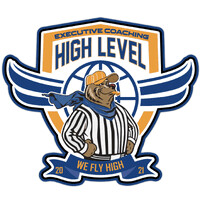
High Level Executive Coaching
Focus Areas: Executive coaching, personal development, leadership transformation
Certifications / Background: Over 20 years of experience in creating breakthroughs and transforming lives
Client Types / Industries: Individuals seeking personal and professional growth
Notable Media / Content: Affiliations with organizations such as Inspire & Develop Artists, Staten Island Chamber of Commerce, and Covenant House

Starla Sireno
Focus Areas: Executive coaching for individuals, teams, and organizations
Certifications / Background: Founder of NYC Coach Collective; committed to The 10% Commitment initiative
Client Types / Industries: Corporate leaders seeking personal and professional development
Notable Media / Content: Advocates for integrating personal growth with professional success

Dr. Joel Mausner
Focus Areas: Executive coaching, leadership development, organizational consulting, career advancement
Certifications / Background: Ph.D. in Psychology; over 25 years of experience in organizational and leadership consulting
Client Types / Industries: Corporate leaders, healthcare executives, non-profit organizations, small business owners
Notable Media / Content: Active member of professional associations including the American and New York State Psychological Associations, the Society of Consulting Psychology, and the Organization Development Network

Anita Kishore, PhD, ACC
Focus Areas: Executive coaching, leadership development, emotional intelligence, mindfulness
Certifications / Background: Ph.D. in Chemistry from the University of Georgia; MPA from NYU Wagner School of Public Service; Associate Certified Coach (ACC) with the International Coaching Federation; certified in Hogan Assessment Suites, EQ-i2.0 Emotional Quotient Inventory, Leadership Circle Profile (LCP 360), and MBTI
Client Types / Industries: Senior executives, government leaders, underrepresented leaders across various industries
Notable Media / Content: Instructor in Leadership at NYU, iCoachGlobal, and the National Institutes of Health (NIH); featured panelist at NYU Wagner’s Women in Consulting Panel

Samya Ahmed
Focus Areas: Business management, organizational behavior, leadership development
Certifications / Background: Details about specific certifications or educational background are not provided in the available sources.
Client Types / Industries: Primarily involved in higher education, teaching undergraduate students in business management.
Notable Media / Content: No specific publications or media features are noted in the available information.
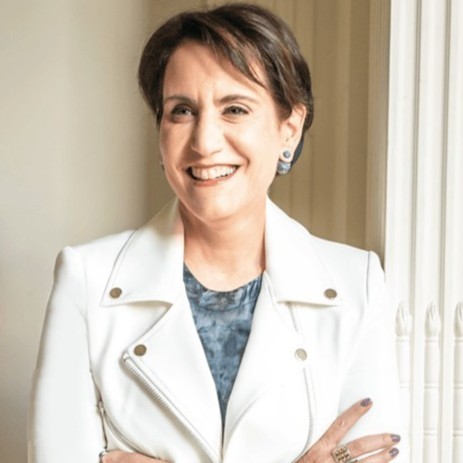
Danielle Gibson
Focus Areas: Executive coaching, leadership development, communication strategies, personal growth
Certifications / Background: Extensive experience in coaching individuals and leaders to enhance communication and confrontational skills
Client Types / Industries: Professionals across various sectors seeking to improve assertiveness and leadership capabilities
Notable Media / Content: Author of insightful blogs on confrontation and leadership; offers workshops and individual coaching sessions
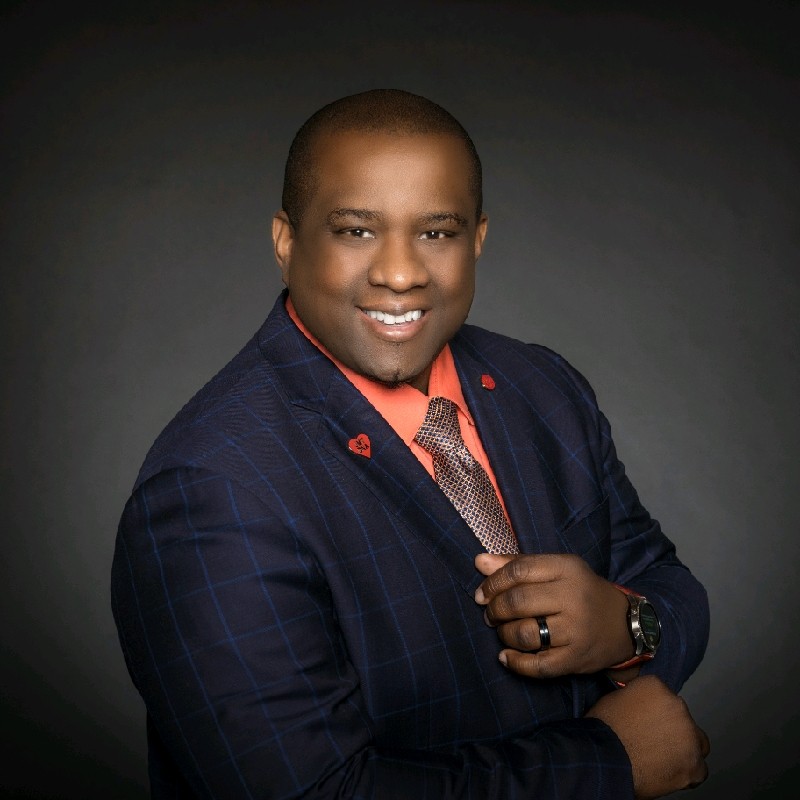
Ifoma Pierre
Focus Areas: Real estate coaching, business development, leadership training, social media marketing
Certifications / Background: Licensed Real Estate Associate Broker with over 15 years of experience. Creator of the G.E.M. Coaching Program, specializing in enhancing real estate agents’ marketing skills. EXIT Realty International Corporate Trainer. Holds multiple designations, including ABR, GRI, MCNE, SRS, PSA, e-PRO, CBR, ITI. Certified Speaker, Trainer, and Coach with the John Maxwell Team.
Client Types / Industries: Real estate professionals, entrepreneurs, business executives
Notable Media / Content: Featured speaker at various real estate conferences and events. Developer of training programs focused on sales, marketing, branding, and advanced social media lead generation strategies.

Milica (Mili) Ristic
Focus Areas: Leadership and mindset coaching, personal and professional development, entrepreneurship, women’s empowerment
Certifications / Background: Certified Consultant of the Proctor Gallagher Institute; over two decades of corporate experience; multilingual professional recognized for achievements in the sales industry
Client Types / Industries: Business leaders, entrepreneurs, professionals seeking personal growth, with a focus on empowering women
Notable Media / Content: Contributor to The Daily Drip; creator of the Female Fatal Academy; featured in Bold Journey Magazine

Isabella M. Camasura
Affiliated Firm: Ralph Lauren
Position: Associate Manager, Diversity, Equity, and Inclusion
Focus Areas: Diversity, equity, and inclusion (DEI); learning and development; people operations; university recruitment; systems analysis; change metrics
Certifications / Background: Extensive experience in DEI initiatives and people operations within the fashion industry
Client Types / Industries: Fashion and retail sectors
Notable Media / Content: Active contributor to DEI programs and initiatives at Ralph Lauren

Andrea (Andi) Mignolo
Focus Areas: Executive coaching, leadership development, organizational design, complexity, consciousness, emergence, learning
Certifications / Background: MBA from Weatherhead School of Management at Case Western Reserve University; Professional Certified Coach (PCC); former design and product executive with over a decade of experience; certified Realization Process teacher
Client Types / Industries: Visionary leaders and teams across various industries committed to building better futures
Notable Media / Content: President of the Interaction Design Association (IxDA); creator of the cohort-based course “Leader as Coach”; author of “The Becoming” and “Words Make Worlds” newsletters

Dr. Justin Calapp
Focus Areas: Organizational behavior change, leadership development, psychological safety, growth mindset
Certifications / Background: Ph.D. with 25 years of experience as a business practitioner, entrepreneur, and advisor to Fortune 100 and Global 500 organizations in the Financial Services and Manufacturing industries
Client Types / Industries: Fortune 100 and Global 500 organizations, particularly in Financial Services and Manufacturing
Notable Media / Content: Featured speaker in the Friday Conversation Series discussing psychological safety and the SCARF model

Vanessa Wasche
Focus Areas: Executive communication coaching, public speaking, leadership presence, presentation skills
Certifications / Background: MFA from New York University; BFA from the University of Minnesota; professional acting experience with appearances on CBS’s The Good Wife and Person of Interest
Client Types / Industries: CEOs, executives, emerging leaders across various industries
Notable Media / Content: Contributor to Fast Company; featured speaker in various workshops and bootcamps on effective communication

David Leaver
Focus Areas: Sales effectiveness, business growth strategies, organizational development
Certifications / Background: Over 30 years of experience in sales and business development; co-founder of Opus Partners, Inc.
Client Types / Industries: Various industries seeking to enhance sales processes and achieve growth
Notable Media / Content: Contributor to the Opus Partners blog, sharing insights on sales strategies and business growth

Nathaniel Kelliehan
Affiliated Firm: Ralph Lauren
Position: Manager, Social Partnerships & Philanthropy
Focus Areas: Social impact, corporate philanthropy, partnership development
Certifications / Background: Extensive experience in managing social partnerships and philanthropic initiatives within the retail apparel and fashion industry
Client Types / Industries: Retail apparel and fashion
Notable Media / Content: Active contributor to Ralph Lauren’s social impact strategies and philanthropic programs

Vanessa Tennyson
Focus Areas: Executive and leadership coaching, behavioral authenticity, organizational development, emotional intelligence
Certifications / Background: Professional Certified Coach (PCC) accredited by the International Coach Federation; Columbia Certified Professional Executive and Organization Coach (3CP); Senior Certified Professional (SHRM-SCP) by the Society for Human Resource Management; over 30 years of C-suite experience in professional services, non-profit management, human resources, financial management, administration, and operations
Client Types / Industries: Executives, senior leaders, and organizations across various industries seeking leadership development and organizational growth
Notable Media / Content: Developer of “The Triad of Discovery” coaching framework; featured in interviews and articles discussing leadership development and encore careers

Nancy Sherr
Focus Areas: Executive and career coaching, mid-career reinvention, leadership development, organizational effectiveness
Certifications / Background: Over 22 years of corporate experience, including significant roles during a company’s growth from 750 to 45,000 employees; extensive experience in hiring and leading top-tier teams
Client Types / Industries: Mid-career professionals, executives, and organizations seeking career advancement and leadership development
Notable Media / Content: Contributor to HuffPost on topics related to mid-career reinvention; developer of the “CareerDNA” coaching program

Peter Bregman
Focus Areas: Executive coaching, leadership development, organizational change, emotional courage
Certifications / Background: B.A. from Princeton University; M.B.A. from Columbia University; recognized as the #1 executive coach by Leading Global Coaches; ranked as a Top 30 thought leader by Thinkers 50 Radar
Client Types / Industries: CEOs and senior leaders in organizations such as Allianz, Twilio, Electronic Arts, CBS, Mars, Citi, and numerous VC-backed startups
Notable Media / Content: Host of the Bregman Leadership Podcast; regular contributor to Harvard Business Review; author of multiple best-selling books, including Leading with Emotional Courage and 18 Minutes
The Future of Coaching Is Credible, Contextual, and Human
New York City has always been a proving ground for leaders, and the same is true for coaches.
The individuals on this list aren’t just coaching frameworks. They’re listening closely, challenging thoughtfully, and showing up for the real work of growth. In a space that often gets crowded with surface-level advice, these professionals are setting a new standard—one built on substance, context, and trust.
We’re honored to spotlight them—and to continue learning from their example.
FAQs
Why wasn’t I featured?
This is a curated list, not an exhaustive one. If you or someone you know is doing great work in coaching, reach out—we’re always listening.
How were these coaches selected?
All featured coaches were chosen based on publicly available information, including content, credentials, focus areas, and the clarity of their online presence.
Are these paid placements?
No. This list is not sponsored, paid, or submitted. It’s grounded in independent research and guided by professional credibility, not popularity.
Leadership coaching is one of the most effective ways to develop strong, capable leaders—yet, in many organizations, it’s still reserved for executives. The reality is, leadership happens at every level. First-time managers, mid-level leaders, and senior executives all face moments where they need guidance, perspective, and support to navigate challenges and grow.
But leadership development doesn’t happen by accident. Great leaders aren’t just born—they’re shaped through self-awareness, feedback, and continuous coaching that helps them improve how they communicate, make decisions, and develop their teams.
Yet most companies don’t provide leadership coaching where it’s needed most.
👉 68% of managers have never received formal leadership training—leaving them to figure it out on their own. (Source: The HR Director)
👉 46% of managers have been asked to provide more constructive feedback, but only 28% feel HR has prepared them for it. (Source: Lattice State of People Strategy Report)
👉 Only 30% of HR leaders say their leadership programs are effectively preparing leaders for future challenges. (Source: Gartner: Top 5 Priorities for HR Leaders in 2025)
For leadership coaching to truly work, it can’t just be a one-off experience or a luxury for a select few. It needs to be practical, relevant, and integrated into the daily moments where leadership actually happens—whether that’s navigating team conflict, giving tough feedback, or adapting to change.
The question isn’t whether leadership coaching is valuable—it’s how to make it work for more people in a way that’s meaningful, actionable, and built to last.
Get the free guide to close your leadership development gap and build the trust, collaboration, and skills your leaders need to thrive.
What Is The Goal Of Leadership Coaching
Leadership coaching is the process of helping leaders improve how they interact with others, make decisions, and develop their teams. It’s not just about individual self-improvement—it’s about equipping leaders to create real impact in their organizations.
A great leader isn’t someone with all the answers. It’s someone who knows how to ask the right questions, adapt to different situations, and bring out the best in others. Leadership coaching provides structured guidance to help leaders grow—not in isolation, but in the context of their teams, their challenges, and their day-to-day decisions.
3 Ideas That Strengthen Leadership Coaching’s Impact
Most leadership coaching follows a traditional, one-on-one model—focused on individual growth, often reserved for executives or high performers. But practicing leadership isn’t just a top-level function—it can happens at every level of an organization.
✅ Leadership coaching should be accessible at every stage.
From first-time managers to senior executives. When mid-level leaders don’t get coaching, they’re left to figure things out alone, which weakens teams and slows progress.
✅ Leadership coaching isn’t just about the leader—it’s about the team.
Leadership doesn’t happen in a vacuum. Effective coaching helps leaders understand their teams’ unique dynamics, improve collaboration, and create an environment where people can thrive.
✅ Leadership coaching should be integrated into daily work—not just scheduled sessions.
Leaders don’t need advice weeks after a tough conversation—they need guidance in the moment, when it matters most.
Make Your Leadership Coaching More Impactful
See How High Performing Teams Use Tech To Equip Their Leaders

Great Coaching Can Lead To A High-Performing Culture
🟢 Self-awareness that leads to action.
Leaders need more than just insight into their strengths, biases, and blind spots—they need to know how to apply that awareness in real interactions. Coaching ensures that self-awareness isn’t just theoretical, but something leaders can actively use to make better decisions and foster stronger teams.
🟢 A focus on building strong teams.
Coaching isn’t just about making a leader better—it’s about helping them bring out the best in others, develop talent, and build trust. When leaders are supported through coaching, they create environments where people feel heard, valued, and empowered to perform at their best.
🟢 Actionable feedback, not vague theories.
Effective leadership coaching offers practical, real-time insights leaders can apply immediately—not just high-level concepts about leadership. The best coaching doesn’t just teach theory; it helps leaders navigate the complexities of managing people, giving feedback, and driving change in the moment
🟢 Scalability and consistency.
Coaching should be continuous, relevant, and available to every leader—not a one-time experience for a select few. When coaching is integrated into daily work, it becomes a consistent driver of growth, rather than an occasional intervention.
The impact is real. One study found that for every $1 spent on coaching, companies saw a return of over $7. Coaching doesn’t just develop better leaders—it leads to smarter decisions, stronger teams, and better business outcomes. When leaders are equipped with the right coaching, they reduce costly mistakes, improve retention, and create cultures of accountability that drive long-term success.
Impactful leadership coaching strategies realize it isn’t just about developing individuals—it’s about changing how leadership happens in an organization. When development opportunities are embedded into daily work—instead of separate initiatives—the effects of coaching start to drive real, lasting change.
4 Principles That Make Leadership Coaching More Effective?
Coaching is about helping leaders apply new learning and discovery to improve team dynamics, decision-making, and workplace culture. But for coaching to drive lasting impact, it has to be personalized, relevant, team-centered, and continuously reinforced.
Let’s break down the key principles that make leadership coaching effective.
1. Personalization: Coaching Should Be Tailored to the Leader and Their Team
No two leaders—or teams—are the same. Coaching should be customized to individual strengths, leadership styles, and team dynamics rather than following a generic framework.
How Personalization Makes Leadership Coaching More Effective
✅ Self-awareness is At The Core Of Better Leadership
Leaders who understand their own tendencies, strengths, and blind spots can make better decisions, communicate more effectively, and create environments where people thrive.
- Behavioral assessment platforms with tools like DISC, MBTI, or Enneagram help leaders understand their natural tendencies, communication styles, and decision-making patterns.
- Strength-based assessments (like CliftonStrengths®) highlight what energizes leaders, helping them maximize their potential.
- When assessment insights can be layered, even better! Leaders get a multi-dimensional view of themselves and their teams—leading to more targeted coaching and better results.
✅ Leadership Coaching Should Adapt to the Team, Not Just the Leader
Leadership isn’t just about self-improvement—it’s about building strong teams. Coaching should help leaders:
- Recognize and adapt to different working and communication styles within their team.
- Navigate team dynamics more effectively, building trust and collaboration.
- Lead in a way that aligns with their team’s strengths—not just their own.
When leaders and teams can both be part of the coaching process, the impact is deeper and longer-lasting. Assessments are just one tool that can make coaching more personal, actionable, and relevant—leading to stronger teams and better leadership at every level.
2. Contextual Relevance: Coaching Should Happen When It Matters Most
Leadership isn’t learned in a vacuum. Leaders need coaching in the moments where leadership skills are required—when they’re giving feedback, navigating conflict, or making tough decisions.
⏳ Why Timing Matters in Leadership Coaching:
Often, coaching opportunities happen out of sync with the actual leadership challenges the individual is facing. A one-hour session weeks before or after a tough conversation doesn’t help a leader navigate it in real time.
Leaders need coaching in the moment, when decisions are being made, feedback is being given, and challenges arise—not weeks later when the details are fuzzy.
Leaders don’t have time to dig through notes from past coaching sessions. They need quick, relevant guidance when they’re about to have a one-on-one, handle a conflict, or make a big decision.
Digital coaching tools can integrate coaching insights directly into platforms like Slack, Outlook, Gmail, and team dashboards, so leaders get nudges right when they need them—not as an afterthought.
Instead of hoping leaders remember what they learned in a coaching session, automating coaching nudges makes insights part of their daily workflow, helping them adjust, improve, and lead better day in and day out.
3. Team-Centered Coaching: Leadership Coaching Should Strengthen the Entire Team
A leader’s success isn’t measured by their individual growth—it’s measured by how well they develop and empower their team. Coaching should help leaders strengthen collaboration, build trust, and bring out the best in others.
This shift from individual leadership coaching to collective leadership coaching is gaining momentum. Many organizations are recognizing that coaching shouldn’t just focus on one leader at a time—it should strengthen leadership across an entire team or organization.
✅ Organizations Are Moving Toward Collective Leadership
- According to DDI’s 2023 Global Leadership Forecast, only 12% of companies feel confident in their leadership bench strength.
- To address this gap, progressive organizations are shifting toward group coaching and team-based leadership development that breaks down silos, encourages shared learning, and creates accountability among peers (td.org.)
- Instead of viewing leadership as an individual skill, collective coaching builds leadership capacity across an entire organization—ensuring teams, not just individuals, are equipped to lead.
✅ Leaders Need Coaching on How to Motivate, Delegate, and Give Feedback
- Coaching is about equipping a leader to create an environment where people can thrive.
- This includes how to provide feedback, resolve conflict, and navigate team challenges—not just how to improve their own leadership skills.
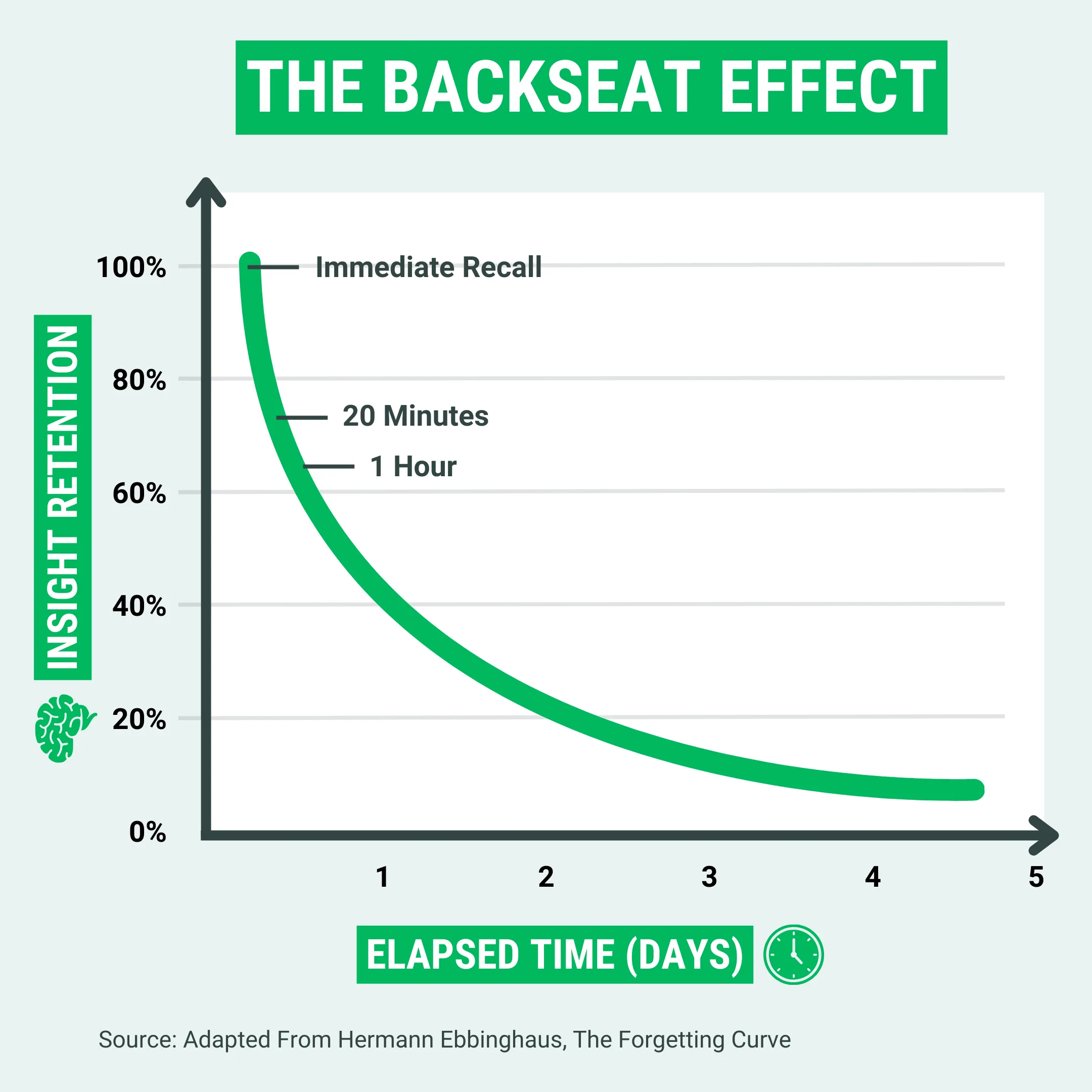
4. Continuous Reinforcement: Coaching Should Be an Ongoing Process, Not a One-Time Event
One of the biggest gaps in leadership coaching is sustainability. Too often, coaching happens in isolated moments—a workshop, a quarterly session—but fails to create lasting behavior change.
How Continuous Coaching Strengthens Leadership Development:
✅ Reinforcement Drives Retention & Real Behavior Change
- Ebbinghaus’s Forgetting Curve shows that people forget up to 70% of what they learn within 24 hours unless it’s reinforced.
- Micro-coaching nudges—like the ones Cloverleaf delivers—help keep leadership concepts top of mind and ensure they’re applied continuously.
✅ Embedding Coaching Into Daily Work Makes It Scalable
- Leadership coaching shouldn’t be a separate initiative—it should be integrated into daily interactions.
- With ongoing, accessible coaching, leaders don’t just get support when they schedule it—they get continuous, relevant insights that shape how they lead every day.
Leadership coaching is most effective when it moves beyond one-size-fits-all approaches and becomes personalized, contextual, team-centered, and continuous.
Organizations that embrace these coaching principles by leveraging assessments, contextual insights, and continuous reinforcement—will develop stronger leaders, more engaged teams, and a leadership culture that scales across every level.
How to Scale Leadership Coaching Beyond the C-Suite
Most leadership coaching is still reserved for senior executives. Traditional coaching models—like one-on-one coaching engagements—are expensive, time-consuming, and difficult to scale. As a result, mid-level managers and first-time leaders often don’t get the support they need.
But leadership isn’t just a top-level function. If coaching is only available to a select few, organizations miss a massive opportunity to strengthen leadership across the board.
To scale leadership coaching in a way that’s both effective and sustainable, organizations need a model that:
✅ Supports leaders at every level, not just executives.
✅ Provides on demand, relevant coaching—not just scheduled sessions.
✅ Uses technology to make coaching accessible, personalized, and continuous.
Why Many Coaching Models Cannot Scale
One-on-one coaching has long been the standard, but it comes with significant limitations when it comes to scaling:
👉 High Cost: Executive coaching engagements can cost thousands of dollars per leader, making widespread adoption unrealistic.
👉 Limited Reach: One coach can only support a handful of leaders at a time, leaving many managers without guidance.
👉 Lack of Continuity: Coaching sessions happen in intervals, leaving gaps where leaders struggle to apply what they’ve learned.
Companies looking to expand leadership development across their organization need a more scalable, accessible, and embedded approach to coaching.
How to Scale Leadership Coaching Without Losing Impact
✅ Think Of Leadership Coaching Beyond The Executive Level
Leadership development shouldn’t just be for the top 10% of the company. Mid-level managers, first-time leaders, and high-potential employees also need structured guidance, feedback, and coaching.
👉 Instead of limiting coaching to a few individuals, organizations should make leadership coaching a core part of development at all levels.
👉 Group coaching, collective development, and technology-driven coaching nudges can make leadership support accessible to a much larger audience.
✅ Leverage Technology to Democratize Coaching Opportunities
Leadership coaching can be expensive, time-consuming, and hard to scale. One-on-one coaching engagements can cost thousands of dollars per leader, making it unsustainable to provide coaching across an entire organization.
Technology helps remove these barriers, making coaching more cost-effective, accessible, and scalable without sacrificing personalization.
👉 Reduce Cost Without Losing Impact
One-on-one coaching can cost thousands per leader. Scalable coaching tools provide consistent, high-quality coaching insights at a fraction of the cost.
👉 Eliminate Scheduling Bottlenecks
Coaching often relies on pre-scheduled sessions, leaving leaders without support when challenges arise. Digital coaching tools provide on-demand insights when leaders need them most.
✅ Shift from Episodic Coaching to Ongoing Development
Leadership coaching is less effective when it is experienced as one-and-done event. For real impact, coaching must be continuous, integrated, and reinforced over time.
👉 Micro-Coaching Nudges Keep Leadership Skills Top of Mind
Instead of relying on infrequent sessions, coaching should be woven into daily work through real-time insights and reminders.
👉 Leadership Development Must Align with Real-World Challenges
The best coaching happens in the moment—when leaders are making decisions, giving feedback, or navigating conflict.
By leveraging technology, expanding access, and making coaching continuous, organizations can equip every leader with the support they need to develop, lead effectively, and build stronger teams.
Coaching More Leaders, Strengthening More Teams
Leadership coaching has the power to transform organizations—not just by improving individual leaders but by creating stronger teams, better communication, and cultures where people thrive.
With new approaches and technology, coaching is no longer limited to a select few. It can be personalized, continuous, and embedded into daily work, making leadership development more impactful than ever before.
When more leaders get the coaching they need, workplaces become more connected, teams work better together, and cultures become places where people want to stay and grow.
Cloverleaf can help make this possible for your team. Your leaders can get the right insights at the right time—so they can lead with confidence, develop their teams, and create lasting impact.
See how Cloverleaf can strengthen your leadership coaching strategy.
Coaching in the workplace isn’t working the way it should.
At least, not for most teams.
Over the last decade, workplaces have changed dramatically. Teams are more distributed. Change is relentless. Employees want more support—but they aren’t getting the coaching they need to grow.
And yet, many organizations still approach coaching like they did in 2010.
- Coaching is reserved for executives while managers and employees miss out on meaningful development.
- Coaching happens outside of daily work, making it difficult for employees to apply what they learn.
- Managers are expected to carry the full weight of coaching—without enough support or tools to make it sustainable.
Leaders aren’t ignoring coaching. They’re investing in it, making time for it, and trying to do it well. But despite those efforts, coaching often feels inconsistent, unsustainable, or limited in impact.
It’s not because coaching isn’t valuable. It’s because the way it’s being delivered isn’t built for today’s workplace.
Instead of coaching being event-based, time-bound, and exclusive, it needs to be woven into everyday interactions—accessible to everyone when they need it most.
To make that shift, coaching needs to:
- Reach beyond leadership circles and become a company-wide practice.
- Happen in the moments that matter—before key conversations, during collaboration, and as challenges arise.
- Be scalable—so coaching isn’t another burden on HR or managers but a shared practice that strengthens teams.
Coaching shouldn’t feel like adding more work. It can be your team’s most valuable tool—when it’s done differently.
👉 So, what needs to change? Let’s break it down.
See How Cloverleaf Scales Coaching In The Workplace
Why Coaching Is Different From Other Management Strategies & Why It Is More Effective
Workplace challenges today aren’t the same as they were 10 years ago. But most leadership coaching models haven’t changed to match them.
Managers are expected to motivate, engage, and grow their teams, but they’re still being taught an outdated approach:
Management is about control, while coaching is about discovery.
- The old-school management model is directive—leaders assign tasks, monitor progress, and correct mistakes.
- Coaching, on the other hand, encourages employees to explore solutions, ask questions, and take ownership.
Managing focus on execution while coaching builds problem-solvers.
Coaching leads to success because it facilitates psychological capital, a positive psychological resource that coachees can apply to their day-to-day work experiences. – psychologytoday.com
- Management ensures work gets done. Coaching ensures employees know how to think through challenges independently.
- In today’s fast-moving, constantly shifting workplace, employees need to be adaptable, not just productive.
Coaching must evolve beyond a top-down model.
- Coaching shouldn’t just be a leader-to-employee activity—teams grow best when development happens across all levels, not just when managers make time for it.
- Relying solely on managers for coaching slows down team development and prevents employees from learning alongside one another.
What’s the shift?
Coaching should be a shared team practice—accessible to everyone, not just leaders, and embedded into daily work rather than relying solely on managers to drive it.
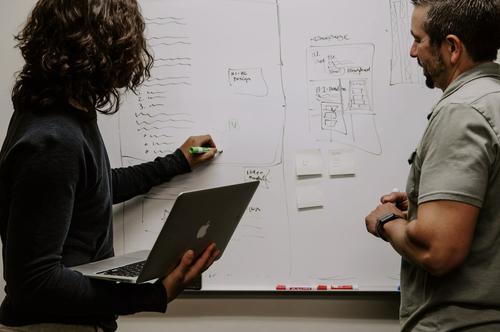
Why 2010-Era Coaching Is Holding Your Team Back
Coaching has always been a valuable part of leadership and team development. But in many organizations, it hasn’t evolved alongside the workplace itself.
Teams operate differently than they did a decade ago—communication is faster, collaboration is more fluid, and challenges emerge in the moment. Yet, many companies still use program models that don’t match today’s realities.
Instead of helping teams grow together, coaching often is:
- Exclusive – Reserved for executives and high-potential employees, leaving most managers and team members without meaningful support.
- Disconnected from daily work – Delivered through workshops, quarterly reviews, or one-off training sessions that quickly fade from memory.
- Overly dependent on managers – Coaching is framed as a leadership responsibility rather than an organization-wide practice.
It’s not that these methods never worked—it’s that they were built for a different kind of workplace.
Three Major Gaps in Traditional Coaching
1. It’s Exclusive—Only Leaders Get Coached
Most coaching is designed for senior executives or “high-potential” employees. Managers and employees—who would benefit the most—are left without meaningful development opportunities.
- The problem: When coaching is limited to a select few, teams lose out on daily opportunities for growth.
- The impact:
- 68% of managers have never received formal leadership training, leading to misalignment, disengagement, and poor team performance.
- Employees receive little to no coaching unless they are identified as high-potential, which can lead to a lack of motivation and unclear career development.
2. It’s Disconnected—Training Happens Away from Real Work
Most coaching and leadership training happens in scheduled sessions or offsite programs. But by the time employees return to their day-to-day work, much of what they learned is forgotten or never applied.
- The problem: Coaching is treated as an event rather than something employees can apply in their daily roles.
- The impact:
- 90% of what people learn in training is forgotten within a month without reinforcement.
- Employees lack support when they need it most—before key conversations, during challenges, or when giving feedback.
3. It Overloads Managers—Too Much Pressure, Not Enough Support
Managers are expected to drive all coaching and development for their teams, yet they are already juggling multiple responsibilities. Without the right tools and shared accountability, coaching becomes another overwhelming task.
- The problem: When coaching is only a manager’s responsibility, it doesn’t get the attention it deserves.
- The impact:
- Managers struggle to balance coaching with other demands, leading to inconsistent application.
- Employees don’t receive consistent feedback or growth opportunities because coaching isn’t built into the team’s daily interactions.
Coaching is meant to unlock potential—but when it’s tied to outdated structures, that potential stays untapped.
If coaching isn’t embedded in how teams work together every day, it becomes another initiative instead of a real driver of growth.
So, what does modern, scalable coaching look like?
Let’s break it down.
The Future of Coaching in the Workplace: Scalable, Embedded, and Team-Driven
Workplace coaching is at an inflection point. Organizations are investing more in coaching than ever before—yet many employees still aren’t receiving the development they need.
A recent study found that 9 out of 10 companies plan to increase their investment in coaching over the next 12 months. But if coaching remains exclusive, disconnected from daily work, and overly reliant on managers, those investments won’t create the lasting impact organizations expect.
Coaching isn’t just an HR initiative or a leadership skill—it should be a shared, everyday practice that strengthens teams at every level.
What Needs to Change?
For coaching to drive real results, it must move beyond traditional approaches that limit its reach and effectiveness. Here’s what needs to happen:
- Coaching must be available to every employee, not just a select few. Too often, coaching is reserved for senior leaders or high-potential employees, leaving the majority of the workforce without meaningful development.
- It must be part of daily work—not something that happens in training rooms or scheduled sessions. Coaching that only occurs in structured programs often fails to translate into long-term behavior change.
- It must be shared—coaching isn’t something managers should have to carry alone. When employees learn how to coach and support each other, development becomes a continuous, team-driven process.
A recent Harvard Business Review article reinforces this shift, advocating for leaders to act as coaches and integrate development into daily interactions rather than treating it as a separate function.
How Coaching Must Evolve
Many organizations recognize the need for coaching but are still using outdated strategies. Here’s what’s changing:
- From Leadership-Only → Teamwide Development
- Coaching should extend beyond managers to become a team practice that helps everyone improve.
- From Generalized Training → Personalized, Context-Aware Coaching
- Employees need coaching that is relevant to their work, strengths, and challenges—not just one-size-fits-all advice.
- From Training Events → Coaching in the Flow of Work
- Development needs to happen in the moment, guiding employees before key conversations, collaboration, or decision-making.
Organizations that make these shifts will create a workplace where coaching isn’t just an occasional intervention—it’s a continuous driver of team success.
Coaching That Fits Today’s Workplace
Coaching doesn’t have to be another task on a manager’s plate or a one-off training initiative. It can be woven into how teams work, learn, and grow together.
Companies that embrace scalable, embedded coaching will see stronger teams, greater agility, and a workforce that continuously improves—without adding to the burden of HR or leadership.
How to Make Coaching Scalable, Personalized, and Embedded in Workflows
To truly transform coaching in the workplace, organizations need a strategy that makes development accessible, relevant, and ongoing.
That means moving beyond traditional coaching models and embracing a scalable, personalized, and embedded approach that allows coaching to happen naturally throughout the workday.
Here’s how to make that shift:
1. Shift from Manager-Led Coaching to Teamwide Development
When managers are the only ones expected to drive coaching, it limits how often development happens and puts unnecessary pressure on them.
Instead, coaching should be something that happens across the team in everyday interactions.
- Employees learn how to coach each other—providing feedback, support, and development beyond just manager interactions.
- Managers serve as facilitators rather than the sole source of coaching—making team development more sustainable.
- Teams build a culture where growth and learning happen in the moment, not just in structured sessions.
When coaching is shared across the team, employees take more ownership of their development—leading to stronger collaboration, problem-solving, and continuous growth.
2. Embed Coaching in Daily Tools & Workflows
Coaching is most effective when it happens in the moment—before a critical conversation, during a challenge, or when an employee is struggling with feedback.
Yet, most coaching happens outside of the flow of work, making it difficult to apply when it matters most.
- Coaching insights are delivered directly through the tools employees use every day (for instance, Slack, Microsoft Teams, Email, Calendar).
- Instead of waiting for formal coaching sessions, employees receive personalized guidance right before key interactions—helping them apply learning instantly.
- Coaching becomes part of daily work, eliminating the need for extra meetings or long training sessions.
When coaching is embedded into daily workflows, employees don’t have to “find time” for development—it happens seamlessly as they work.
3. Automate Personalized Coaching to Make It Scalable
One of the biggest challenges with coaching is scalability. Many organizations struggle to provide consistent, high-quality coaching to every employee because coaching has traditionally required time-consuming, manual efforts.
Technology powered coaching changes that.
- Automated coaching insights provide personalized, context-aware guidance for every team member—without requiring more from managers.
- Employees receive just-in-time nudges that help them develop leadership, communication, and collaboration skills in their daily roles.
- Coaching becomes scalable across the entire organization, ensuring every employee has access to meaningful development.
By automating coaching that is personalized and relevant, organizations can provide continuous development without adding administrative burden.
When coaching is:
Shared across the team (not just led by managers),
Embedded into daily workflows (not isolated to training sessions), and
Made scalable with automation (not limited by HR resources),
…it becomes an organic, ongoing part of team success.
When coaching is built into the way teams work—not treated as a separate initiative—it strengthens collaboration, deepens trust, and drives measurable performance improvements across the organization.
How Teams Experience Coaching Differently With Cloverleaf
Most coaching happens in moments that are too little, too late. A leadership workshop here. A quarterly review there. A training session that sounds good in theory but never sticks in practice.
And then, employees are left to figure it out on their own—without support, without reinforcement, and without a way to apply what they’ve learned when it actually matters.
It’s not that organizations don’t want to coach better. It’s that traditional coaching structures aren’t built for the way work happens today. Cloverleaf makes coaching a continuous, integrated part of team growth—not something separate from the work itself.
Coaching Can Be a Daily Practice, Not a Leadership Perk
In many organizations, coaching is reserved for leadership development programs—positioned as something “extra” rather than essential. That means only a handful of employees ever experience it in a meaningful way.
Cloverleaf flips this model. Instead of coaching being locked away in executive training, it’s woven into the way teams work every single day.
- No applications. No waiting for the next workshop. No limited access. Every employee gets coaching insights designed for their role, their strengths, and the way they collaborate with others.
- Development moves from leadership training to a team-wide skill. Employees don’t just get coached; they learn how to coach each other—strengthening team trust and collaboration.
Coaching should amplify team dynamics, not just individual performance. When everyone is part of the process, teams move faster, make better decisions, and work together more effectively.
Coaching That Happens When It Matters Most—Not After the Fact
Coaching programs can suffer from poor timing. Employees learn something in a training session but don’t apply it for weeks—or worse, forget it entirely.
With Cloverleaf, coaching happens in the moment when people actually need it.
- Before a big meeting? Cloverleaf delivers insight on how to communicate more effectively with each teammate.
- Navigating a difficult conversation? Get guidance on how to frame feedback constructively.
- Leading a cross-functional project? Cloverleaf helps teams anticipate collaboration challenges before they derail progress.
This isn’t about dumping more information onto employees—it’s about giving them exactly what they need, when they need it.
Growth doesn’t happen in scheduled sessions. It happens in real work moments. Cloverleaf makes sure coaching is there when it counts.
Managers Get Support—Instead of Carrying the Entire Weight of Coaching
Managers know they need to develop their teams, but most aren’t given the support to do it well. They’re expected to coach, give feedback, manage team dynamics, and drive results—all on top of their own responsibilities.
Cloverleaf removes the coaching bottleneck by making team development a shared responsibility:
- Managers get real-time insights into how their team works best together. Instead of guessing how to motivate or support their people, they get coaching prompts tailored to individual and team strengths.
- Teams take an active role in their own development. Employees aren’t waiting on their managers to facilitate growth—they’re actively engaging in coaching insights that help them collaborate, communicate, and problem-solve better.
- Coaching becomes embedded in team culture. Instead of being another task for managers, it’s a natural part of how teams work together.
When coaching is shared across a team, it doesn’t just lighten the load on managers—it strengthens the entire organization.
Why Organizations Are Moving to Cloverleaf
For coaching to create lasting impact, it has to be more than a program—it has to be part of the way teams operate.
That’s exactly what Cloverleaf delivers.
- Scalable coaching that reaches every employee, not just leadership.
- Personalized insights tailored to each person’s work style, strengths, and role.
- Timely guidance that helps employees navigate work challenges in the moment.
- A shift from manager-led development to a team-wide coaching culture.
The workplace has changed. Coaching should too.
How Technology Helps Leaders and Teams Develop Stronger Coaching Practices
Coaching is about asking the right questions, at the right time, in a way that drives real learning and growth. But for many leaders, coaching feels like something they should do rather than something they feel equipped to do effectively.
Technology bridges this gap by making coaching a natural, structured, and ongoing part of leadership and teamwork. Instead of leaving leaders to figure it out on their own, micro coaching tools provide the right coaching prompts, at the right moments, to help teams grow together.
Here’s how technology helps leaders and team members develop and apply better coaching skills in everyday work:
1. Coaching Conversations That Happen When They Matter Most
Great coaching starts with great questions. But in the middle of a fast-paced workday, most leaders don’t have time to stop and think, What’s the best coaching question to ask right now?
How technology helps:
✅ Personalized coaching prompts before one-on-one meetings, performance check-ins, or feedback conversations.
✅ Digital coaching can suggest the right coaching question based on the employee’s goals, strengths, and challenges.
✅ Real-time nudges reminding leaders to ask questions that spark meaningful reflection—before important conversations, not after.
📌 Example: Before a manager’s 1:1 with a direct report, a coaching tool like Cloverleaf could suggest:
Your team member has been working on improving their communication in meetings. Try asking: ‘What’s one thing you did differently in today’s meeting that worked well?’
Why it works: Instead of relying on memory or instinct, managers get structured guidance to make their coaching more effective.
2. Scaling the Coaching Habit Across Entire Teams
Coaching needs to be a team practice to truly transform a workplace. However, most employees don’t naturally think of coaching each other, and many managers feel like they have to carry the weight of coaching alone.
How technology helps:
✅ Team-wide coaching insights that encourage self awareness and emotional intelligence.
✅ Strength-based coaching insights that help employees understand how to collaborate more effectively based on each other’s personalities and work styles.
📌 Example: A team working on a high-stakes project receives a nudge in their Slack channel:
Before your next meeting, try asking each other: ‘What’s the biggest challenge you’re facing right now, and how can we support you?’
Why it works: Instead of waiting for managers to initiate coaching, teams learn to support each other in the flow of work.
3. Coaching That Adapts to Different Team Members
Not every employee responds to the same coaching style. Some thrive on direct, action-oriented coaching, while others need space for reflection. Coaching can feel frustrating for managers and employees without insight into how each person thinks, communicates, and solves problems.
How technology helps:
✅ Personality-based coaching insights that guide managers on how each team member prefers to receive feedback and coaching.
✅ Behavioral assessments integrated into coaching tools, helping leaders adapt their approach based on individual strengths.
✅ Situational coaching recommendations that adjust based on team dynamics.
📌 Example: Before providing constructive feedback, a manager receives a coaching insight:
Your team member prefers a solutions-oriented approach. Instead of focusing on what went wrong, try asking: ‘What’s one adjustment you can make next time?’
Why it works: Coaching becomes personalized and effective, rather than one-size-fits-all.
4. Reducing the Mental Load of Coaching
One of the biggest reasons leaders don’t coach more often? Cognitive overload. In fast-paced environments, coaching feels like just one more thing to remember—and when people are overwhelmed, they default to what’s easiest: giving directives instead of coaching.
How technology helps:
✅ Automated coaching prompts that eliminate decision fatigue, helping leaders focus on the conversation, not what to ask next.
✅ Seamless integration with daily workflows, so coaching becomes a natural extension of work—not an extra task.
✅ Data-driven insights that show progress over time, giving leaders confidence that their coaching is making a difference.
📌 Example: Instead of a manager scrambling to prepare for a feedback session, an automated coaching tool can provide a nudge like:
Your team member thrives on positive reinforcement and practical next steps. Instead of focusing solely on outcomes, try asking: ‘What part of your approach felt most effective? How can I support you in refining it further?’
Why it works: Leaders spend less time thinking about how to coach—and more time actually doing it.
Technology Doesn’t Replace Coaching—It Makes It Better
At its core, coaching is about human connection—helping people grow, solve problems, and reach their potential. Technology doesn’t replace that—it enhances it by making coaching more structured, more scalable, and more embedded in everyday work.
When leaders and teams have the right tools to support coaching conversations, they don’t just know what to do—they actually do it.
🚀 With coaching technology, every leader can become a great coach, and every team can build a culture of continuous learning.
When leadership fails to evolve, organizations pay the price. Misaligned priorities, disengaged teams, and slow decision-making can ripple through every layer of a business, creating costly delays and missed opportunities. Yet even as companies invest heavily in technology and technical skills, the critical human capabilities—like communication, adaptability, and emotional intelligence—often take a back seat.
For executive coaches, this presents both a challenge and an opportunity. It’s no longer enough to deliver value during sessions alone. True impact happens in the moments between meetings, where behaviors are shaped, decisions are made, and leadership growth truly takes root.
This is where executive coaching assessment tools can shine. By combining the depth of proven assessments (for example: DISC, 16 Types, Enneagram, and others) with the power of technology to automate just in time insights, coaches can amplify their influence—helping leaders align behaviors with business outcomes, even when you’re not in the room.
The Untapped Potential Of Executive Coaching Assessment Tools
Leadership assessment tools have long been a cornerstone of executive coaching, but their true potential often goes untapped. For many coaches, these tools remain static—limited to diagnostic reports or one-off feedback sessions. Yet today’s most pressing leadership challenges—communication bottlenecks, low emotional intelligence, and burnout under constant change—demand a more dynamic approach.
Get the full report to build a talent assessment strategy that works as hard as your team.
See Cloverleaf’s Powerful Assessment Tools In Action
Executive leaders don’t need abstract personality reports—they need tools that help them show up better in their daily interactions, from critical decision-making meetings to one-on-one conversations with their teams.
Popular coaching assessments like DISC, 16 Types, and StrengthsFinder are powerful starting points, but their real potential lies in how they’re applied.
The challenge for coaches is ensuring that the insights uncovered during a session actually translate into meaningful action when it matters most.
Here’s the good news: technology is making it possible to move beyond static assessments. Digital coaching tools can integrate insights and data-driven insights from assessments into a leader’s daily workflow, delivering timely and personalized coaching nudges that reinforce behavior change and emotional intelligence.
These nudges don’t replace coaching sessions—they enhance them, giving leaders practical reminders to apply what they’ve learned in the real-world context of their workday.
How do different assessment tools support executive leaders’ most pressing challenges:
- DISC: Communication bottlenecks are a common pain point for leaders managing diverse teams. DISC helps pinpoint where a leader’s communication style may be creating friction. When paired with technology, DISC insights can provide specific tips before meetings—like how to tailor messaging to the decision-makers in the room—resulting in faster alignment and stronger collaboration.
- 16 Types (MBTI-Based): Leaders often face cognitive diversity in their teams, which can lead to misaligned priorities. MBTI helps leaders understand their own problem-solving style and how it complements (or clashes with) others. When integrated into a platform like Cloverleaf, these insights become actionable, reminding leaders to adjust their approach during critical conversations to foster better strategic outcomes.
- Enneagram: Emotional blind spots can erode trust and hinder resilience in high-pressure situations. Enneagram reveals patterns of stress and motivation, helping leaders recognize and manage their triggers. With digital coaching, these patterns can be transformed into ongoing prompts—such as how to reframe challenges during periods of stress—building a foundation of emotional agility.
- StrengthsFinder (CliftonStrengths): Leaders who lean into their natural strengths can inspire greater team engagement and performance. StrengthsFinder helps identify these strengths, and digital coaching ensures leaders have actionable reminders—like how to use a strategic mindset to resolve conflict—embedded directly into their day-to-day tasks.
Technology enables these assessments to go beyond diagnostic tools. By delivering just-in-time insights exactly when and where they’re needed—whether before a team meeting or via on-demand searchability—digital coaching platforms bridge the gap between awareness and action, helping leaders practice and refine key behaviors in the moments that matter most.
The result is a new way of thinking about assessments: not just as tools for discovery but as dynamic instruments coaches can use with their clients to create real change. By leveraging technology to personalize and contextualize these insights, coaches can extend their impact, ensuring leaders are equipped to overcome the complex challenges of their roles every single day.
Choosing and Applying the Right Assessment Tools
Assessment tools are not one-size-fits-all. For executive coaches, the value lies in choosing tools that align with both the unique needs of their clients and the goals of the organizations they lead. It’s not just about identifying strengths or stress triggers—it’s about matching the right tool to the right leadership challenge, ensuring the insights are actionable and lead to measurable change.
1. Tailoring Tools to Leadership Challenges
Each assessment brings a different lens to understanding leadership behaviors:
- DISC is ideal for leaders navigating communication and collaboration challenges across departments.
- 16 Types (MBTI-Based) works well for teams grappling with cognitive diversity and strategic alignment.
- Enneagram is very helpful for leaders working through E.Q. development or managing high-pressure environments with diverse groups of people.
- StrengthsFinder (CliftonStrengths) helps leaders shift focus from fixing weaknesses to maximizing their natural talents for team success.
2. Integrating Technology for Seamless Application
Traditional assessments provide foundational insights, but pairing them with digital coaching platforms transforms them into actionable tools. Digital platforms allow coaches to:
- Provide leaders with timely coaching nudges that align with their daily challenges—reminders and actionable prompts delivered exactly when they can be applied to reinforce behavior change and emotional intelligence
- Connect coaching outcomes to leadership’s core objectives by focusing on productivity gains, cost efficiency, and employee retention. Highlight measurable improvements, such as faster project delivery times, reduced turnover, or enhanced customer satisfaction, to showcase coaching as a strategic, long-term investment..
- Ensure coaching insights remain impactful by integrating them into key workday moments, such as preparing for high-stakes meetings, delivering constructive feedback, or making critical decisions. This context-driven approach keeps growth tied to real-world leadership priorities.
3. Balancing Diagnostic and Developmental Use
While some assessments excel at diagnosing leadership tendencies, others provide more developmental guidance. For example:
- Use DISC to diagnose communication bottlenecks, then integrate automated coaching nudges to help leaders refine their tone and messaging.
- Combine StrengthsFinder with a digital coaching platform to reinforce daily application of a leader’s top strengths in complex team scenarios.
4. Leveraging Multiple Tools for Holistic Leadership Growth
No single assessment can capture the full complexity of a leader’s personality, behavior, and decision-making style. By combining multiple tools, coaches can create a richer, multidimensional view of a leader’s strengths, challenges, and potential. This holistic approach allows for more targeted coaching strategies that address the leader as a whole, rather than focusing on isolated traits or behaviors.
For example:
- Broader Perspectives on Leadership Dynamics: Using tools like 16 Types and Enneagram together reveals both cognitive diversity and emotional tendencies, helping leaders navigate strategic decisions while staying attuned to team dynamics and interpersonal challenges.
- Balancing Strengths with Adaptability: StrengthsFinder identifies where leaders excel naturally, while DISC highlights how their communication style impacts team interactions. Together, these tools ensure leaders can lean into their strengths while adapting their approach to meet the needs of different personalities and scenarios.
- Aligning Insight with Action: Combining assessment tools equips coaches with layered insights, enabling them to connect abstract concepts—like personality traits or stress triggers—to specific leadership behaviors. This integration makes development plans more actionable and relevant to the leader’s unique challenges.
By weaving insights from multiple tools into a cohesive coaching strategy, coaches can help leaders uncover blind spots, amplify their strengths, and address areas for growth with precision. The result is a comprehensive development approach that not only enhances individual performance but also drives measurable team and organizational success.

Increasing Impact With Digital Coaching Assessment Tools
Leadership growth doesn’t happen in a vacuum. It’s shaped by the moments that demand clear decision-making, thoughtful communication, and emotional resilience. For coaches, the challenge is to sustain that growth beyond scheduled sessions, ensuring that insights translate into consistent, actionable change. This is where continuous coaching—powered by digital platforms—comes into play.
1. Sustaining Momentum Between Coaching Sessions
Leadership coaching sessions often deliver a burst of valuable insights, but without reinforcement, those lessons can fade in the busyness of day-to-day leadership. Embedding coaching technology into your services helps ensure that the behaviors and strategies discussed in sessions are consistently reinforced through:
- Just-in-Time Nudges: Timely reminders to apply key takeaways in real-world situations, such as preparing for a meeting or navigating a team conflict.
- Contextual Insights: Coaching nudges tied to specific work scenarios, like giving feedback to a team member or managing cross-functional collaboration.
2. Turning Insights Into Daily Action
Even the most insightful assessments have limited impact if leaders can’t integrate them into their daily routines. Automated coaching bridges the gap between awareness and action by embedding growth into everyday workflows:
- Digital platforms deliver actionable prompts directly into workplace tools leaders already use, like Slack or email.
- Leaders receive reminders aligned with their schedules, ensuring they practice and refine behaviors during the moments that matter most.
3. Building Resilience and Adaptability
One of the most critical roles of a coach is helping leaders navigate uncertainty and change. By delivering consistent, real-time coaching, continuous coaching:
- Reinforces stress-management strategies during high-pressure situations.
- Helps leaders reframe challenges and stay adaptable in the face of shifting priorities.
4. Measuring Growth Over Time
Automated coaching also provides measurable insights into leadership development, allowing coaches to track progress and tie growth to business outcomes:
- Competency Gains: Highlight improvements in communication, team alignment, or emotional intelligence.
- Tangible Outcomes: Showcase how coaching has improved employee retention, accelerated project timelines, or strengthened customer satisfaction.
The Value of Automating Your Coaching In Your Client’s Day To Day
Continuous coaching doesn’t replace traditional coaching sessions’ deep, personal connection—it amplifies it. By reinforcing key lessons, supporting leaders in their day-to-day challenges, and making growth measurable, coaches can drive lasting leadership development and demonstrate clear ROI to their clients.
The Future of Executive Coaching: Leveraging AI and Data
The coaching landscape is undergoing a seismic shift. As organizations strive for agility and leaders face mounting pressures to navigate complexity, the demand for innovative coaching solutions is at an all-time high. At the heart of this transformation lies the integration of AI and data—two forces reshaping how coaches engage with clients, measure progress, and deliver sustained impact.

Personalization at Scale: Beyond the One-Size-Fits-All Approach
AI-driven coaching platforms like Cloverleaf are bridging the gap between generalized advice and deeply personalized guidance. These platforms craft tailored coaching insights that evolve with the leader’s journey by analyzing individual assessments, behavioral data, and team dynamics. The result? Executive leaders receive nudges and prompts that align with their strengths and opportunities and the immediate demands of their day-to-day roles.
- Example: Instead of broad recommendations on improving communication, AI identifies a leader’s upcoming team meeting and provides tips tailored to the personalities and preferences of the attendees. This shift transforms abstract concepts into actionable steps that drive real-world results.
Contextual Guidance: Coaching in the Flow of Work
Traditional coaching often pauses between sessions, leaving leaders to connect the dots independently. AI changes this by delivering context-specific insights precisely when and where they’re needed—whether during a high-stakes negotiation or while resolving a conflict within their team. This “in-the-moment coaching” ensures that learning is not just theoretical but immediately applicable, fostering faster behavior change and measurable outcomes.
- Emerging Trend: As platforms integrate with tools like Slack, Teams, or email, coaching becomes a seamless part of a leader’s workflow, removing the friction of accessing development resources and embedding growth into their daily routine.
Measuring ROI Through Real-Time Data
For executive coaches, demonstrating value has often been a challenge. How do you quantify the impact of improved emotional intelligence or better communication? AI and data analytics are changing the game. Platforms now offer dashboards that track behavior shifts, team dynamics, and competency growth, tying coaching outcomes directly to metrics that matter, such as project completion rates, employee retention, and engagement scores.
- Key Takeaway: Coaches can now present clear, data-backed narratives to their clients, showcasing how targeted interventions drive both individual and organizational success.
Preparing for the Future of Coaching
The adoption of AI doesn’t diminish the coach’s role—it amplifies it. By automating repetitive tasks and delivering timely insights, AI allows coaches to focus on what they do best: fostering deep, transformational growth in their clients. As these technologies evolve, the potential to integrate coaching with broader organizational systems—like HRIS platforms or performance management tools—will create a unified approach to leadership development.
A Paradigm Shift for Coaches
For executive coaches, the future isn’t about replacing in-person sessions with automation; it’s about reimagining how coaching can extend beyond the room. AI-driven tools empower coaches to amplify their reach and impact, ensuring leaders are equipped with the insights they need—right when needed. By embracing AI and data, coaches are not just adapting to a new era of leadership development—they’re helping define it.
Getting Started With Executive Coaching Assessment Tools
The integration of digital tools and assessments into your coaching practice doesn’t have to be overwhelming. With the right approach, you can enhance your services, provide measurable value to your clients, and make your coaching more impactful than ever. Here’s how to begin:
1. Define the Needs of Your Clients and Their Organizations
Before diving into tools, take a step back to clarify your coaching objectives:
- What are your clients’ most pressing challenges? Are they struggling with communication bottlenecks, strategic alignment, or managing team dynamics?
- What outcomes matter most to their organizations? Productivity, employee retention, and faster decision-making often top the list.
By identifying these priorities, you can select tools and methods that directly address both individual and organizational needs.
2. Select the Right Assessments for the Job
Not all tools are created equal, and the effectiveness of your coaching depends on aligning the right tools with your goals.
- DISC: Ideal for improving communication and collaboration within diverse teams.
- 16 Types (MBTI-Based): Helps navigate cognitive diversity and align strategic priorities.
- Enneagram: Perfect for fostering emotional intelligence and self-awareness.
- StrengthsFinder (CliftonStrengths): Encourages leaders to leverage their natural strengths while fostering team engagement.
Don’t stop at just using one tool. Consider how combining insights from multiple assessments can provide a holistic picture of your client’s leadership style and growth areas.
3. Introduce Digital Coaching Tools to Bridge the Gap Between Sessions
Digital platforms like Cloverleaf empower coaches to extend their influence beyond the traditional coaching model by embedding insights into the leader’s workflow. Here’s how to get started:
- Onboarding Clients to the Platform: Help your clients navigate tools and understand how to use insights to their advantage.
- Set Expectations: Explain how personalized coaching nudges will complement in-person sessions by reinforcing key behaviors in real time.
- Integrate into Existing Workflows: Choose tools that integrate seamlessly into email, Slack, or Teams to keep coaching actionable and accessible.
4. Create Measurable Goals and Feedback Loops
Clients and stakeholders alike want to see the tangible impact of coaching. Build a framework for measuring growth:
- Define Specific Metrics: Set clear goals such as improved team alignment, reduced conflict, or faster project delivery times.
- Use Data Dashboards: Many platforms provide real-time data on client progress. Share these insights during sessions to celebrate wins and identify areas needing attention.
- Implement Reflection Practices: Tools like Cloverleaf’s Reflections feature enable clients to track their own progress, fostering accountability and self-awareness.
5. Stay Ahead of the Curve
The world of coaching is evolving rapidly, and staying informed about emerging trends will keep your practice competitive:
- Leverage AI and Automation: Learn how tools can provide just-in-time nudges, personalized coaching, and context-specific insights.
- Stay Client-Centric: Regularly evaluate how your methods are serving your clients and adjust your approach based on their feedback.
- Invest in Your Learning: Explore certifications or resources that deepen your understanding of digital coaching platforms and tools.
Getting Started is Easier Than You Think
The journey to integrating technology into your coaching doesn’t have to be daunting. By starting small—selecting a single tool or assessment to pilot—you can build confidence, refine your approach, and demonstrate immediate value. As you see success, you’ll be better equipped to scale your offerings and bring even greater impact to your clients and their organizations.
Executive coaching is evolving, and so are the tools that enable it. By integrating proven assessment methods with the power of technology, coaches can create a coaching experience that extends beyond the boundaries of a single session. Digital coaching platforms make it possible to deliver personalized, actionable insights at the exact moments when they matter most, empowering leaders to grow in real time while solving their most pressing challenges.
For coaches, the opportunity is clear: leverage these tools to deepen your impact, measure your results, and scale your expertise to support more clients and teams. By shifting from static assessments to dynamic, technology-driven solutions, you position yourself at the forefront of an industry that’s transforming how leaders learn, grow, and lead.
Ready to elevate your coaching practice? Discover how Cloverleaf’s Automated Coaching™ can help you integrate assessment tools, deliver measurable insights, and amplify your impact across entire organizations. Explore the possibilities and see how you can create meaningful, lasting change for your clients.
One of the most pressing challenges for coaches and consultants today is proving the measurable impact of their work. Coaching, while transformational for individuals and teams, often delivers its most profound results in areas that can seem intangible—qualities like improved self-awareness, enhanced communication, and better conflict resolution. These competencies shape the fabric of high-performing teams. Yet, many leadership teams struggle to see the ROI because traditional metrics don’t easily capture the link between these human-centered skills and hard business outcomes. To bridge this gap, coaches must focus on competency-based coaching, which allows for measurable, high-impact results that resonate with organizational goals.
Recent research underscores an urgent need for this targeted approach to development. According to Gartner, although 76% of organizations are increasing their investment in leadership coaching and programs, only 36% of HR leaders feel these initiatives effectively prepare leaders for the future. This shortfall highlights the competency gap—a gap that coaching is uniquely equipped to address. Similarly, Deloitte’s studies show that 87% of employees view human skills like adaptability and communication as essential to career advancement. Yet, only a slim majority feel that their organizations recognize these skills’ importance. For today’s organizations, the stakes are high: in a rapidly evolving work environment, leaders who lack key competencies can limit a team’s productivity, engagement, and adaptability.
This article makes the case that coaching can directly bridge this competency gap by focusing on targeted, measurable growth in the skills that leadership teams value most. By identifying and developing specific competencies, coaches can empower employees to reduce costly mistakes, communicate more effectively, and make faster, better decisions—transformative improvements that extend beyond individual growth and influence organizational culture and business results.
With the right tools, coaches can go beyond anecdotal evidence and demonstrate their value with insightful data on competency growth. By tracking improvements in areas like conflict resolution or collaboration, coaches can show leadership concrete results that tie directly to productivity, efficiency gains, and engagement and retention metrics. Through this competency-driven approach, coaching emerges not just as a developmental resource but a data-backed, strategic investment that drives sustainable growth and competitive advantage for the organization.
The following offers a practical guide for coaches to demonstrate coaching ROI in a way that resonates with leadership priorities. It provides the data, strategies, and real-world examples needed to make coaching’s impact unmistakable.
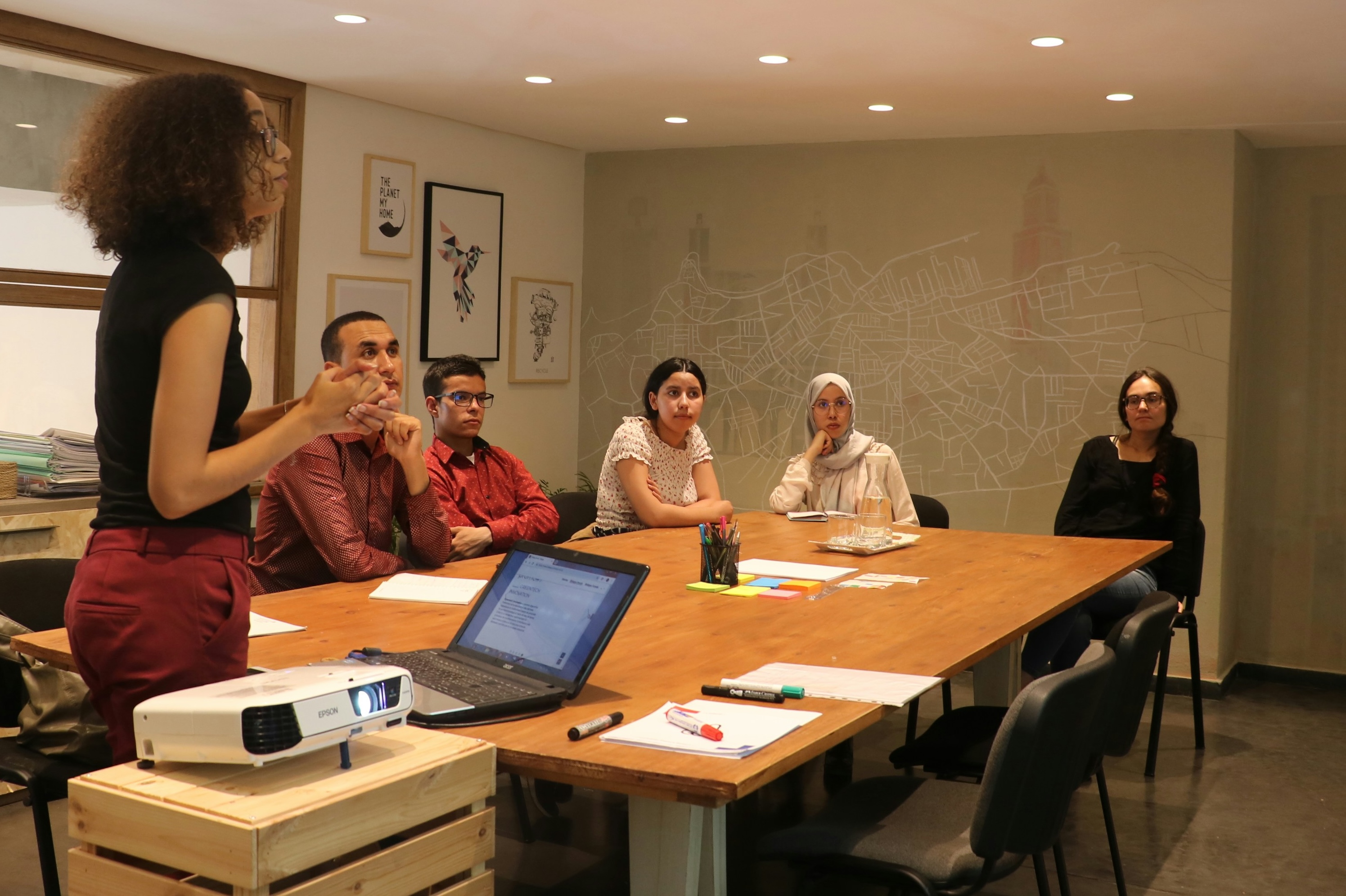
The New Metric To Measure The Impact Of Coaching
For experienced coaches, demonstrating the ROI of coaching through competency growth means showing leadership not just the qualitative benefits but quantifiable change that aligns with business objectives. Metrics that matter to leadership—like productivity, team efficiency, and engagement—are often shaped by core competencies such as self-awareness, conflict resolution, communication, and collaboration. If coaches can connect improvements in key competencies, they can also provide leadership with concrete evidence of coaching’s value by linking personal development directly to organizational performance.
Quantifying Core Competencies To Prove Coaching ROI
Traditional tools like surveys can capture sentiment, but they rarely prove a direct link between development programs and performance outcomes. Leaders in talent development are increasingly seeking ways to measure the actual impact of coaching beyond satisfaction scores, which often lack the depth needed to demonstrate ROI. Rather than defining ROI in terms of immediate financial returns, coaching ROI is best measured through competency growth—the foundation that empowers employees to make better decisions, communicate more effectively, and collaborate productively.
By quantifying improvements in core competencies like self-awareness, conflict resolution, communication, and collaboration, coaches can provide leadership with concrete evidence of coaching’s value. This approach positions coaching as a strategic investment that directly drives key business outcomes, such as productivity, engagement, and operational efficiency.
See How Cloverleaf Increases Coaching ROI
Identifying Key Competencies as Performance Drivers
While leadership teams may be interested in productivity metrics, it’s essential to demonstrate how competencies like self-awareness, communication, and collaboration directly contribute to improved. Here’s how coaches can measure and communicate their impact:
A. Self-Awareness: Self-awareness helps employees recognize their tendencies and adapt their behavior accordingly, leading to more intentional and balanced decision-making. Cloverleaf’s platform further enables this growth, with recent studies showing an 18% increase in feelings of value and recognition among teams using Cloverleaf’s Automated Coaching™, creating an environment of accountability and enhanced job satisfaction that leaders can quantify.
B. Conflict Resolution: Conflict resolution is integral to productivity, as unresolved workplace conflict can become a significant drain on resources. A study from CPP Global found that workplace conflict costs U.S. companies approximately $359 billion annually due to time lost managing disputes. Another study by Pollack Peacebuilding Systems found that conflict negatively affects productivity, with employees spending more time resolving conflicts. Coaches who focus on building conflict resolution skills help teams address issues proactively, saving time and reducing project delays.
Cloverleaf’s platform allows coaches to track conflict resolution improvements. A recent study reported a 36% increase in perceived high-quality teamwork among teams using automated coaching tools.
C. Communication: Misunderstandings and inefficiencies can cost teams nearly a full workday each week—an average of 7.47 hours—due to lost time from poor communication (Grammarly State of Business Communication). Cloverleaf’s Automated Coaching™ provides real-time data on communication effectiveness, with recent data showing a 31% improvement in the quality of communication and collaboration. This metric offers leaders concrete insights into how coaching enhances workflow efficiency and reduces rework time, allowing teams to reclaim lost productivity.
D. Collaboration: Collaboration creates innovation and improves project outcomes by combining diverse perspectives. Yet, studies show that only 27.6% of training budgets are dedicated to soft skills like collaboration.Teams that use tools to improve collaboration through personalized, ongoing coaching about working with cross-functional teams and managing different work styles have experienced a 36% increase in quality collaboration, leading to improved cross-functional communication and faster project timelines—outcomes that directly support leadership’s goals of efficiency and innovation.

Reevaluating ROI in Coaching: Competence as the True Metric
For coaching to demonstrate its full value, ROI should be redefined in terms of competency development rather than direct financial gain. Competency growth lays the foundation for the performance improvements leadership wants to see, yet these skills must be applied meaningfully within the organization. As noted in recent insights, ROI in coaching truly materializes when leaders support the implementation of these skills in daily operations, reinforcing the idea that coaching is a long-term investment in both human capital and organizational resilience.
To align coaching with strategic goals, coaches and leaders can collaborate to design assessments that capture skill application in ways that resonate with business needs. For example, a leader who has received coaching in conflict resolution could track improvements in project timelines or reductions in turnover—metrics that connect competency development to clear business value. As Szilvia Olah insightfully notes in this LinkedIn post, ROI in L&D isn’t about money in, money out; it’s about building competence that drives performance. When leaders understand and support this concept, they create an environment where coaching delivers actionable, data-backed outcomes that impact the bottom line.
By focusing on measurable competency growth, coaches can present coaching as a strategic asset that enhances productivity, efficiency, and engagement—demonstrating ROI in theory and practical, quantifiable outcomes that leadership values.
How to Connect Coaching Impact Directly to Competency Gains and Business ROI
To make coaching’s value unmistakable to leadership, connect competency gains to the metrics that matter most to the organization’s bottom line. Focus on how coaching impacts productivity and performance. Use data points, like improvements in project delivery times or reductions in turnover, to demonstrate how coaching contributes to key business goals.
1. Individual-Level Impact: Self-Awareness Drives Smarter Decisions
Show the Value: Increased self-awareness empowers employees to make better decisions, minimizing costly errors and boosting accuracy.
Make It Measurable: Track post-coaching metrics such as error reduction and improved efficiency. Regularly updated, these metrics demonstrate sustained impact.

2. Team-Level Impact: Conflict Resolution and Collaboration Fuel Efficiency
Show the Value: Effective conflict resolution and collaboration lead teams to complete projects faster, with fewer resources.
Make It Measurable: Use tools like Cloverleaf’s Automated Coaching™ to capture teamwork improvements, presenting clear data on project timelines, cost reductions, and team satisfaction.
Case Study: Real-World Results with Automated Coaching™
Context: A large financial services firm leveraged Cloverleaf’s Automated Coaching™ to enhance both individual and team performance.
Results: Employees improved decision-making, reducing errors by 18%. Teams completed projects 20% faster and cut resource use by 12%. The firm also saw a 10% rise in engagement and a 15% drop in turnover over a one-year period.
Key Takeaway for Leadership: Present these metrics as cumulative benefits that show ongoing impact on both performance and cost savings.
3. Align Competency Gains with Leadership’s Priorities
Show the Value: By focusing on productivity gains, cost efficiency, and employee retention, connect coaching outcomes to leadership’s core objectives.
Make It Measurable: Highlight how coaching has improved project delivery times, reduced turnover, or enhanced customer satisfaction. Use data to reinforce competency growth as a long-term investment.
4. Craft a Narrative of Sustained Value
Show the Value: Emphasize competency growth as an ongoing organizational asset that builds resilience and agility.
Make It Measurable: Support your narrative with quarterly or annual updates, creating a continuous ROI story that reinforces coaching’s role in long-term growth.
Demonstrating Coaching’s Lasting Value through Competency-Driven ROI
By linking competency gains to measurable outcomes, coaches can offer leadership a clear picture of coaching’s tangible impact on the organization’s most important goals.
To keep coaching top of mind as a strategic asset:
- Prioritize Relevant Metrics: Continuously connect coaching outcomes to the metrics that resonate most with leadership—whether that’s project efficiency, employee retention, or improved decision-making.
- Make Data-Driven Reporting Routine: Establish a consistent reporting cadence, using data to show how coaching’s benefits accumulate over time and adapt to the organization’s evolving needs.
- Emphasize Long-Term Growth: Remind leadership that competency development is an ongoing journey that builds the organization’s resilience, adaptability, and competitive advantage.
Taking these steps can empower coaches to prove the ROI of coaching and position it as an essential, sustained contributor to business success.
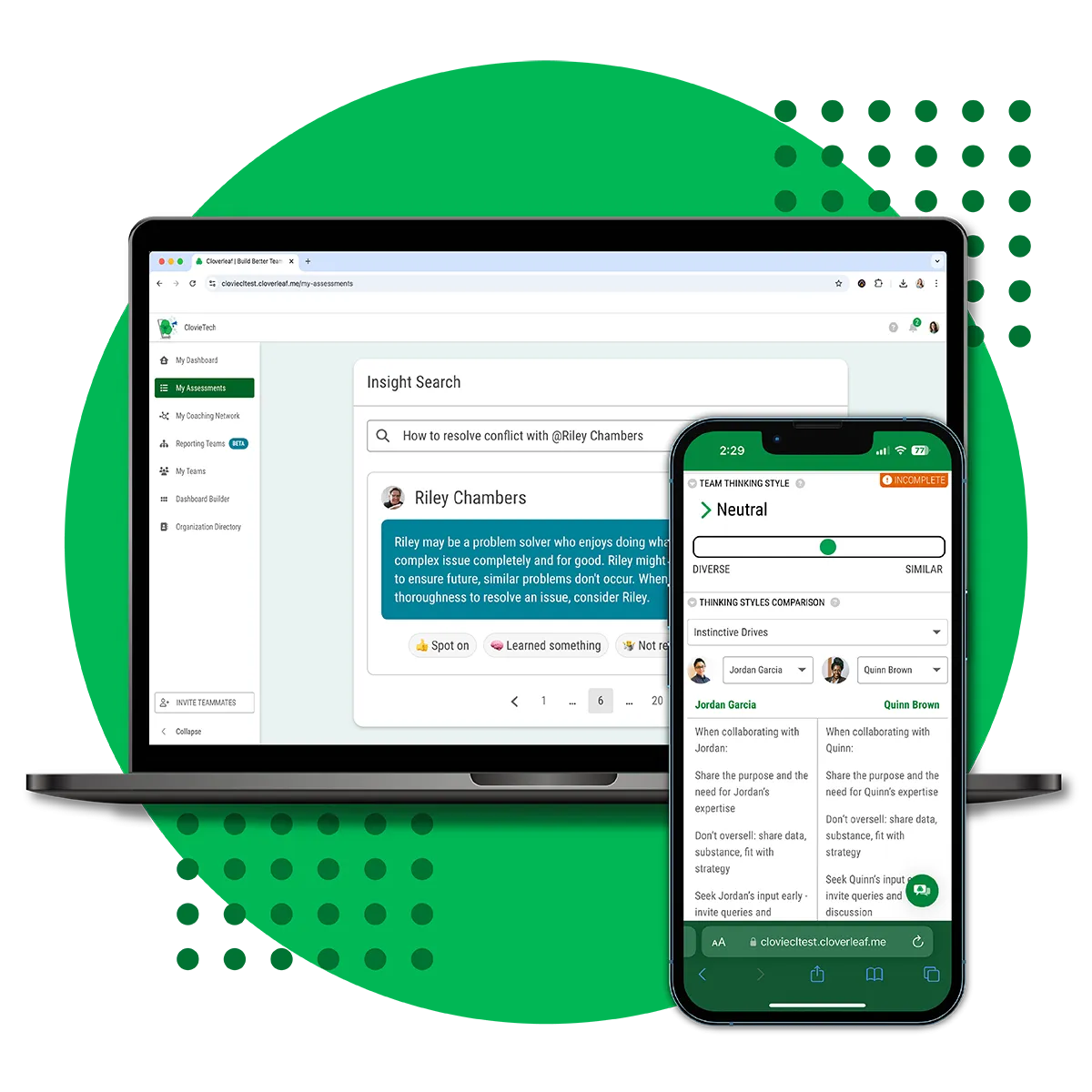
Using Coaching Technology to Prove Competency Growth in Real-Time
For coaches and consultants who already bring incredible value to their clients, finding additional ways to measure the ongoing impact of coaching between sessions can be challenging. Cloverleaf’s Automated Coaching™ creates a powerful way to extend the impact to help clients see measurable development. By delivering ongoing, personalized insights directly into the flow of work, Automated Coaching™ helps coaches demonstrate growth in essential competencies like communication, collaboration, and conflict resolution—providing proof points that reinforce the value of coaching and matter to leadership.
1. Extend Impact Beyond Sessions: Measurable Daily Development with Automated Coaching™
While scheduled sessions allow for deep dives into personal and professional growth, automated coaching tools provide ongoing development opportunities through daily, actionable nudges delivered directly within the tools your clients use every day. On average, Cloverleaf users experience nine micro-coaching “moments” each day, building on what they’ve learned in sessions to reinforce continuous engagement with coaching and growth in competencies like communication, collaboration, and self-awareness.
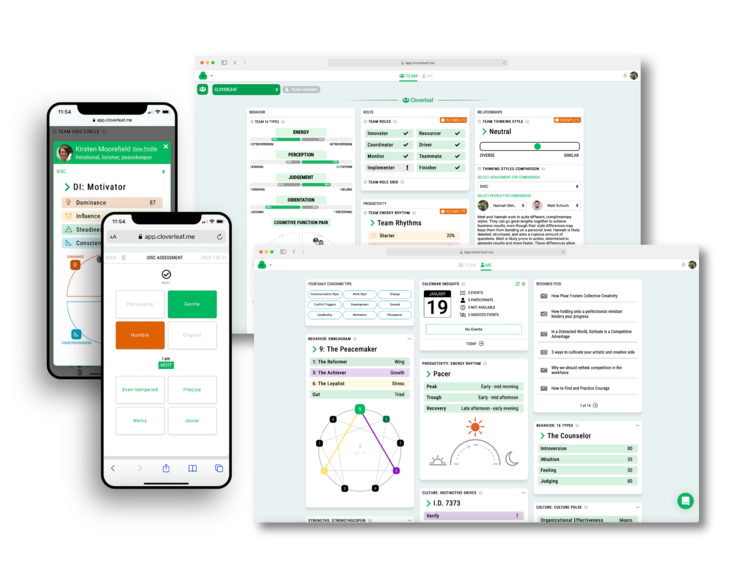
2. Track and Visualize Impact with Personalized Dashboards
Cloverleaf’s Automated Coaching™ dashboards give coaches a way to demonstrate the value of their work through real-time data on individual and team competency growth. These dashboards offer clear, visual insights into how coaching shapes behaviors over time in key areas such as conflict resolution, teamwork, and communication.
Coaches can use this data to:
- Quantify Skills Development: Show clients or organizational leaders how team competencies are improving with tangible metrics.
- Demonstrate Business Value: For example, track how improvement in conflict resolution skills leads to fewer project delays or how better communication reduces rework time—specific metrics that reveal the financial and operational benefits of coaching.
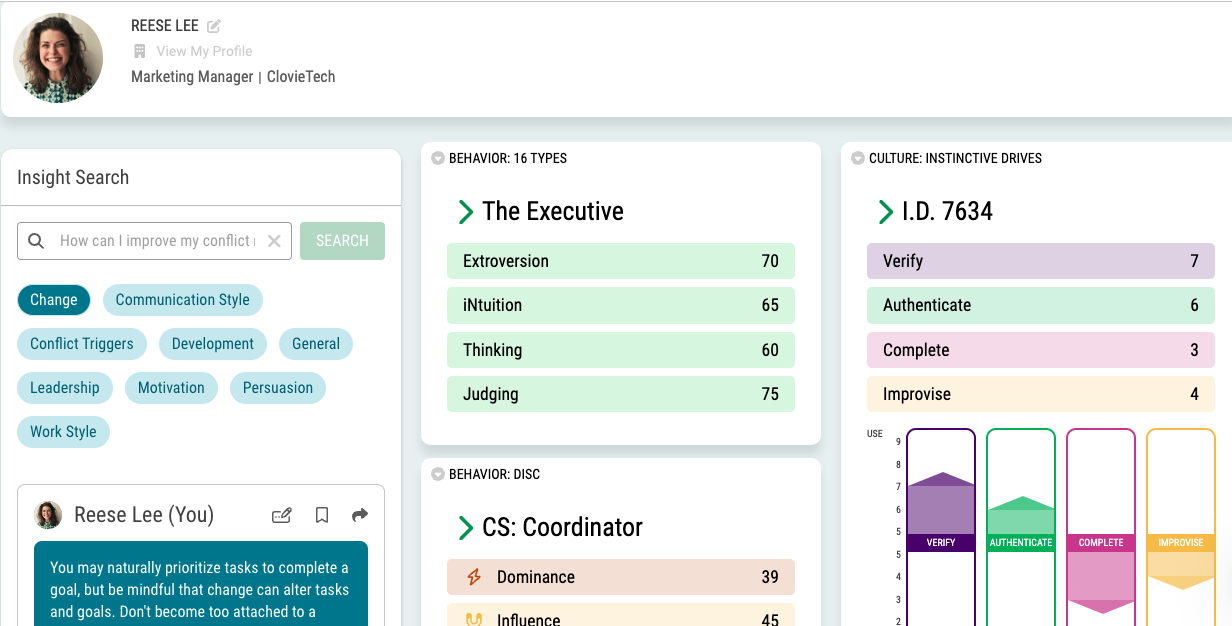
3. Personalize Coaching Focus for Relevant, Targeted Guidance
Coaching is most impactful when it’s relevant to the individual’s unique role and goals. Cloverleaf’s Coaching Focus feature allows coaches to personalize daily coaching insights for each user, aligning with specific objectives to make development both actionable and directly applicable. Whether a team lead is enhancing their feedback skills or a team member is building collaboration capabilities, Automated Coaching™ tailors insights to make growth continuous and meaningful.
Example: A team leader focused on improving communication receives targeted guidance on adapting to each team member’s preferred communication style. This not only enhances their growth but also strengthens team cohesion, providing both immediate and long-term value to the leader’s development journey.
4. Embedding Competency Growth into Daily Workflows
By delivering coaching insights directly within day-to-day workflows, Cloverleaf empowers coaches to create a continuous learning experience that complements their live sessions. Automated Coaching™ reinforces coaching goals, making growth more measurable and actionable:
- Context-Specific Microlearning: Delivered when and where it’s needed, these insights help individuals apply skills in real time, keeping development momentum strong.
- Research-Backed Precision: Automated Coaching™ delivers insights rooted in well-established assessments and proven research, ensuring that each coaching moment is accurate, relevant, and tailored to real growth needs.
Proving ROI with Continuous, Data-Backed Competency Growth
Cloverleaf’s Automated Coaching™ gives coaches the tools to provide evidence-based updates on progress, making it easier to present coaching as a measurable, strategic investment. With data on competency development and tools to drive improvements in key areas, coaches can share regular updates with clients or leadership, proving coaching’s long-term ROI and demonstrating the sustained value of their work.
Positioning Your Coaching as an Essential Driver of Organizational Success
Coaches, your expertise shapes competencies that drive not only individual growth but also the larger goals of any organization. By partnering with convincing and measurable data from tools like Cloverleaf’s Automated Coaching™, you can take your impact even further—bridging the gap between development and demonstrable business results.
Take the Next Step: Use this guide as your blueprint for demonstrating coaching ROI in a way that truly resonates with leadership. Quantify the improvements you see in essential competencies, craft stories that connect growth to measurable outcomes, and position your work as a core contributor to organizational success.
Coaching isn’t just valuable; it’s vital. Let your results speak for themselves—proving that coaching is more than a program; it’s a strategic asset driving productivity, resilience, and long-term growth.
Ready to make coaching outcomes visible and compelling? Discover how Cloverleaf’s Automated Coaching™ can help you measure, track, and communicate the ROI of your work with powerful, real-time data. Learn More About Demonstrating Coaching ROI with Cloverleaf HERE. Or, try our free ROI calculator to see how Cloverleaf can become a revenue generator for you, HERE.
Are you responsible for developing leadership and talent across an organization of hundreds—or even thousands—of employees?
You know how important coaching is for improving performance, fostering growth, and retaining top talent. But here’s the problem: how do you make that coaching truly personalized for each individual without adding a massive burden to your already full plate?
Scaling personalized coaching is one of the biggest challenges leaders face today. While there are countless development platforms out there promising personalization, most fall short when it comes to delivering insights that feel relevant and timely to each individual.
Leaders often end up with generic advice that’s loosely tied to broad milestones or role changes, leaving employees feeling disconnected from the coaching process. In modern organizations where efficiency and effectiveness matter more than ever, personalization at scale isn’t just a “nice-to-have”—it’s a necessity.
Why Personalization Matters To Your Leaders
A one-size-fits-all approach to talent development will struggle to resonate with participants. People want—and need—coaching that reflects their unique challenges, strengths, and daily work contexts.
Generic coaching content not only feels impersonal, but it can also lead to missed opportunities for growth, poor engagement, and even higher turnover.
Personalized coaching, on the other hand, ensures that each employee receives guidance tailored to their specific needs, making it far more impactful.
Most organizations struggle to provide individualized support at scale. Traditional coaching programs require time, money, and manual effort—resources that are in short supply. That’s why the ability to automate personalized coaching has become so crucial.
Automating real-time, context-specific insights allows organizations to deliver tailored support to every employee without burdening their leaders. This kind of personalization is meaningful and can transform your talent development strategy, making it scalable, relevant, and deeply impactful.
The Evolution of Personalized Coaching
Coaching has undergone a significant transformation over the past few decades. Historically, coaching was reserved for senior executives and was often and only delivered through face-to-face programs that focused on broad leadership skills or milestones like promotions. As companies recognized the value of coaching for leadership development, the approach started to shift towards more tailored methods.
One of the key moments in this evolution was adopting a coaching leadership style in the late 1990s, which emphasized individual challenges and goals rather than a programmatic model. This shift was driven by an understanding that people respond better to personalized feedback. Fast-forward to today, coaching has become increasingly data-driven, thanks to the rise of digital coaching tools that allow organizations to collect and analyze behavioral data in real time.
Solutions like automated coaching represent the next phase in this evolution. Platforms like Cloverleaf use technology to provide personalized feedback available at any moment that is specific to the person and their team. This approach moves away from previous methods of sharing coaching or advice during scheduled times or only if people hit job role changes.
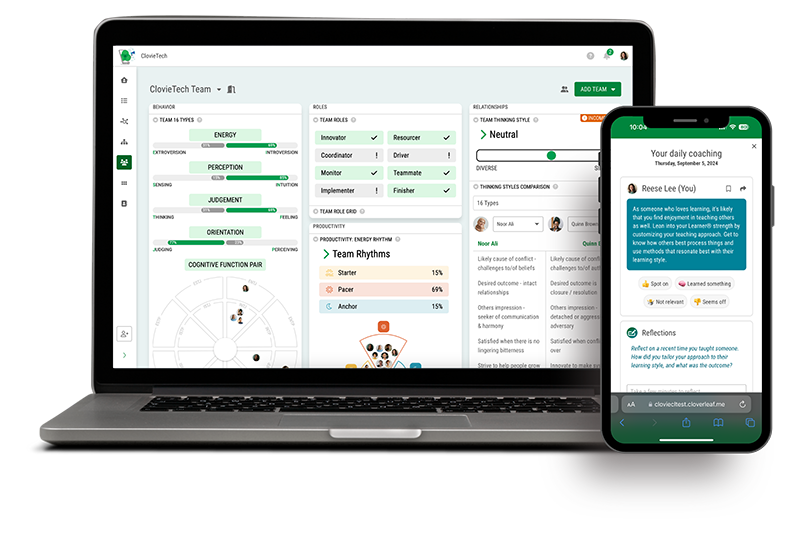
See How Cloverleaf Scales Talent Development
- Daily coaching tips in the tools your team is already working in
- Immediate insights to solve interpersonal challenges quickly
- Team-enabled dashboards to drive more effective performance
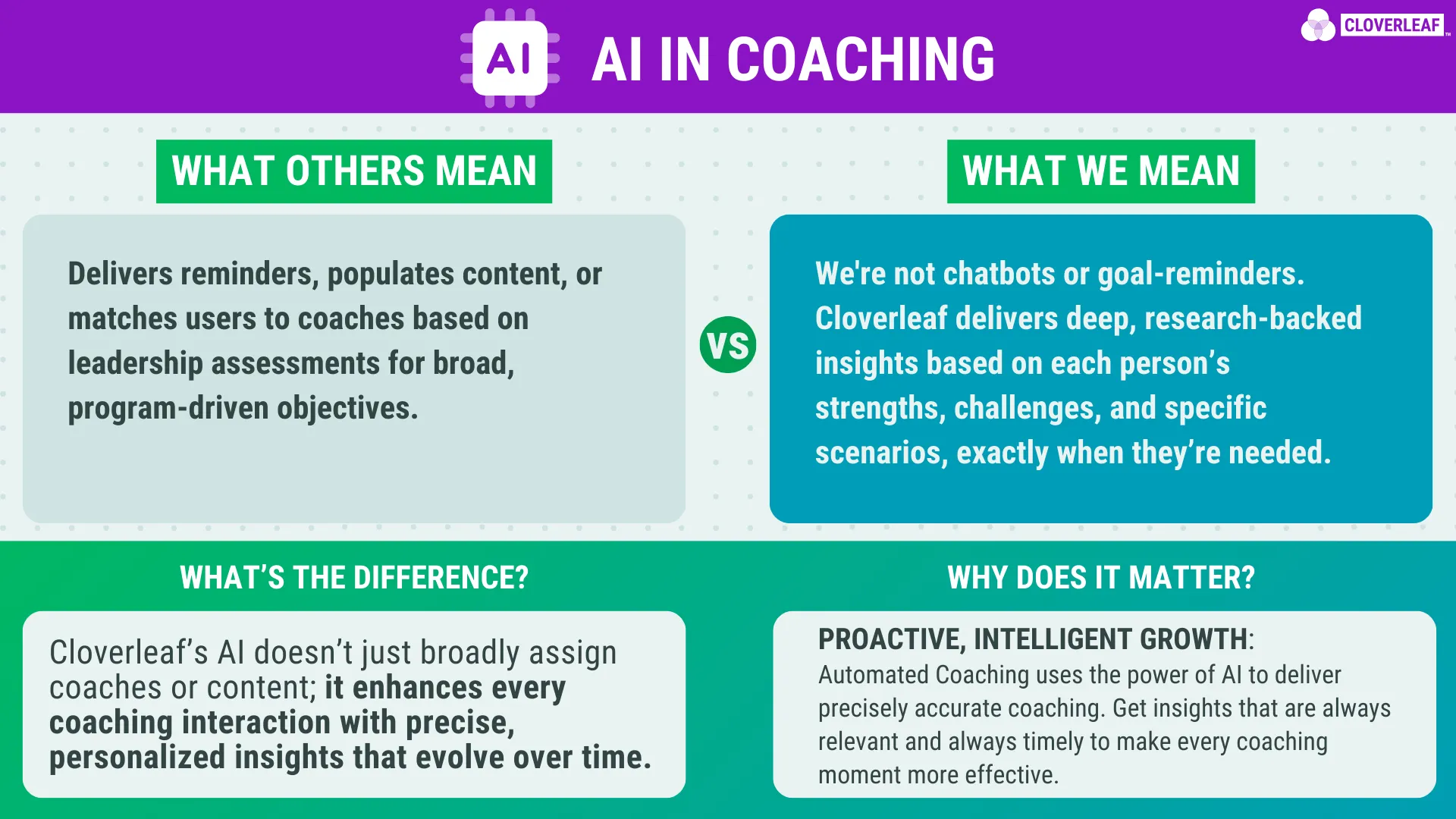
4 Trends That Are Shaping The Future Of Personalized Coaching
1. AI-Powered Coaching:
Generative AI and other technologies are being used to support and enhance coaching efforts. Rather than replacing human coaches, AI acts as a “co-pilot,” offering personalized nudges and prompts to reinforce valuable learning that happens in development programs or during coaching sessions. This extends the coaching process beyond scheduled meetings, ensuring that individuals receive continuous, tailored support.
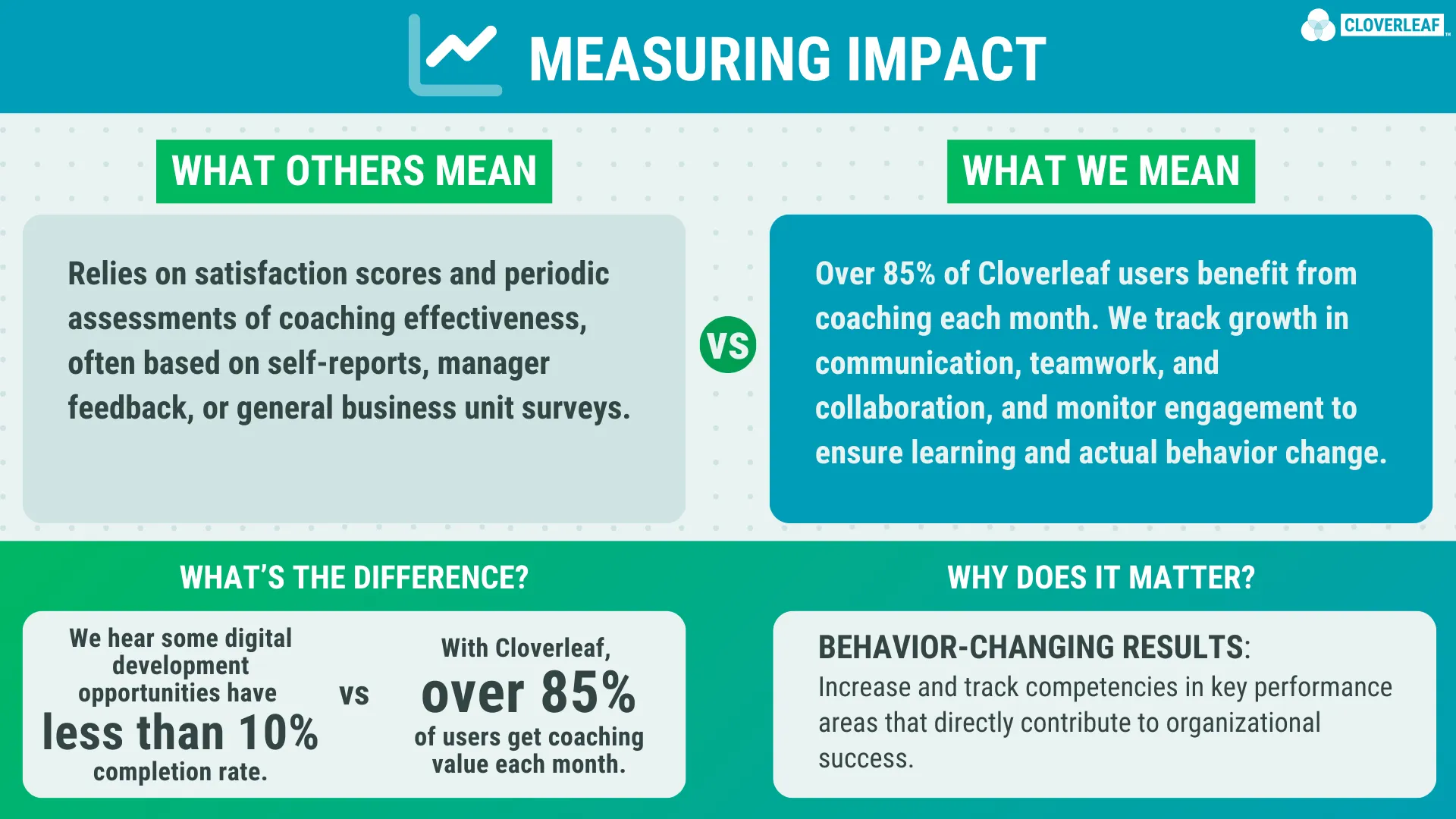
2. Data and Performance Metrics:
Leaders want to know the real impact of coaching. It’s not just about new learning or positive feedback—what matters is whether coaching is actually moving the needle on team performance. Is there a measurable change in behavior and skill application? What’s the return on investment (ROI)? Beyond sentiment and new knowledge, organizations need to see if people’s behaviors are changing in ways that improve the business.
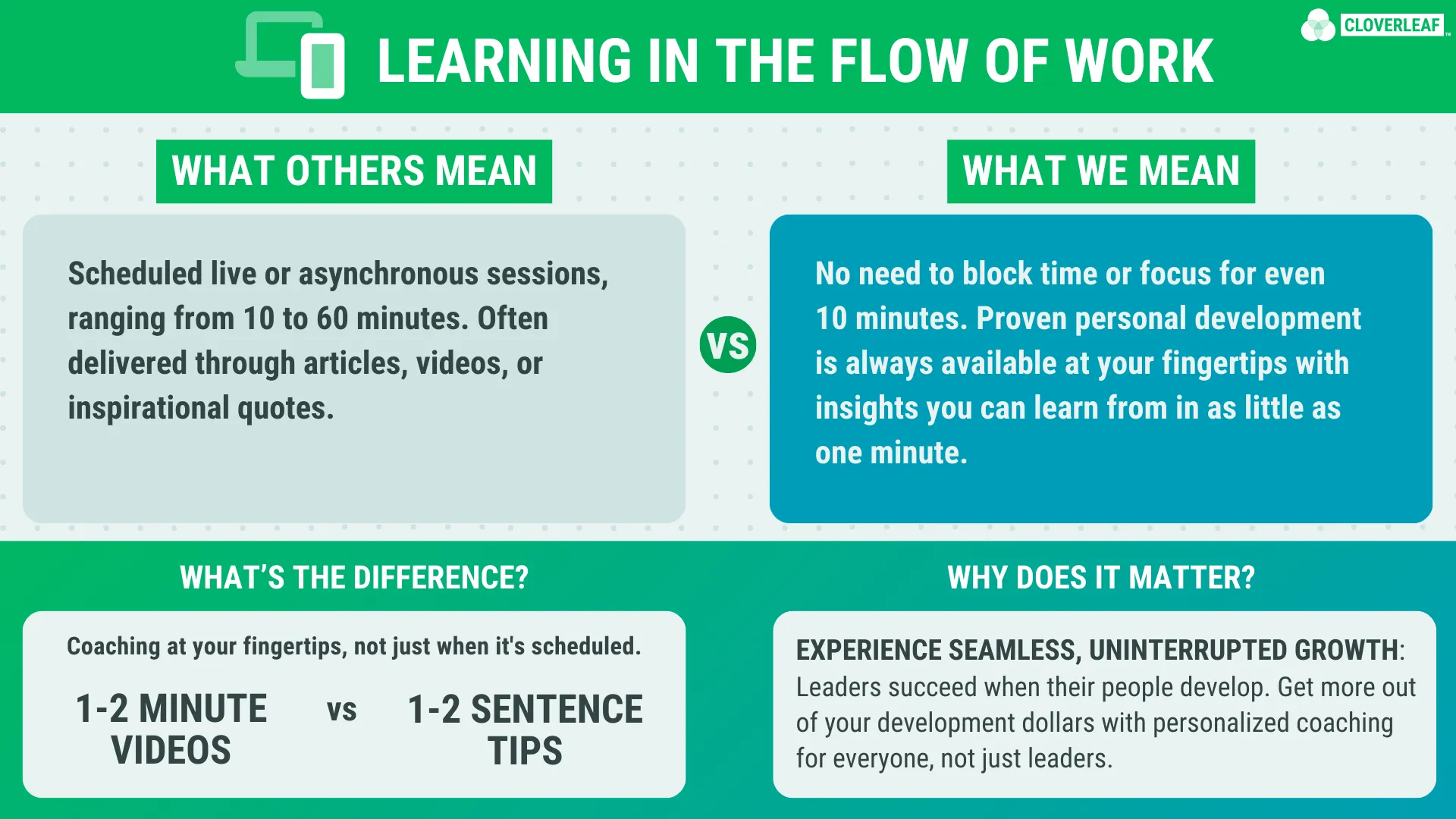
3. Contextualization:
Unlike traditional coaching, available at predetermined times, contextual coaching delivers situation-specific guidance based on an employee’s current work challenges and interactions.
This approach ensures that coaching is actionable and relevant to what’s happening right now, allowing employees to apply the advice immediately, whether it’s before an important meeting or during a critical project, or whenever is best for the individual.
Contextual coaching integrates learning and development into the flow of work, making it both timely and impactful.
This trend is becoming essential as organizations strive to provide more targeted support without adding unnecessary friction to employees’ day-to-day tasks.
4. Remote and Hybrid Coaching:
The shift toward remote and hybrid work environments has pushed coaching to evolve. Virtual coaching, already gaining traction before the pandemic, has now become standard. This trend is further escalated by tools that provide micro coaching moments to ensure each team member receives timely, tailored coaching tips based on their current work challenges and team dynamics throughout their day.
The Demands For Personalization Are Pressing
Despite the advancements in coaching, many platforms struggle to deliver truly personalized coaching at scale. A common issue is that much of the “personalization” offered by many platforms is topical—often limited to role-based advice or broad, milestone-driven coaching. These solutions tend to trigger generic content based on fixed objectives, leading to disengaged participants who don’t feel that the coaching is truly relevant to their immediate needs.
In contrast, automated coaching solves these issues by offering timely, specific advice that is relevant to the individual’s behaviors, strengths, and current work situation. Rather than giving broad, general feedback, it provides coaching that’s action-oriented and contextual because it is about what is happening in the moment. This way, organizations can offer personalized coaching to everyone without overloading their leaders.
By understanding this evolution and leveraging technology, Talent Development Leaders can address the challenges of scaling personalized coaching to drive behavior change and improve performance across their organizations—without overwhelming themselves in the process.
See How Cloverleaf Scales Personalized Coaching
Take a look at Cloverleaf’s key features that can empower your people, build trust, and scale development effortlessly.
The 3 Necessary Components of Effective Personalized Coaching
For personalized coaching to be meaningful and drive behavior change, there are three essential elements to consider: aligning with individual needs, helping employees manage emotions and relationships, and providing support during key moments of work.
Each of these components ensures that coaching becomes practical and relevant, offering insights that people can apply right away to their unique challenges.
1. Resonance with Individual Needs:
For personalized coaching to be effective, it must genuinely connect with each person’s unique challenges and goals. Automated coaching platforms can layer behavioral assessment data like DISC, Enneagram, or 16 Types to better understand how people think, communicate, and approach tasks. This isn’t just about labeling personality traits—it’s about using those insights to provide advice that fits how an individual works in specific situations.
For example, someone who tends to be more detail-oriented may struggle in fast-paced environments. Automated coaching can recognize this tendency and send reminders or strategies to help them manage their workload more effectively in those moments. Likewise, for someone who thrives on collaboration but finds themselves in a remote working situation, the platform can suggest ways to stay connected and communicate more effectively with their team.
This process is powerful because the advice doesn’t come as a generic suggestion, like “work better with your team,” but as specific, situational guidance that feels relevant to what they’re dealing with right now. This could be a tip about managing time before a deadline or a suggestion on how to better frame an idea in a meeting with a team member who thinks differently. In short, it’s advice that feels useful immediately, helping employees put it into practice in the moment.
By providing this type of direct, situation-specific guidance, automated coaching tools make it easier for team members to take what they learn and use it right away, ensuring that the coaching feels both timely and effective.
2. Assist With Managing Emotions and Relationships in Real Time
Another aspect of effective personalized coaching is understanding how emotions and relationships influence workplace success. Emotional Intelligence (EQ) is about recognizing and managing your own emotions, as well as understanding how others feel and react in different situations. Automated coaching technology can consider this by analyzing an employee’s emotional tendencies, such as how they handle stress, communicate under pressure, or lead a team.
Rather than simply giving generic advice, these platforms offer specific, emotionally-informed tips that help employees manage difficult conversations, reduce stress, or adapt their leadership style based on their emotional strengths and challenges.
What makes this approach powerful is that it delivers insights exactly when they’re needed. So, instead of waiting for a coaching session to discuss these challenges, employees receive timely suggestions—for example, a quick reminder to take a breath and stay calm before a high-stakes conversation. Emotional intelligence coaching helps employees stay grounded in the moment and improve how they respond to stressful situations, leading to better team interactions and overall performance.
In high-pressure scenarios, like giving feedback to a team member or handling a tough client call, this coaching helps employees navigate their emotions effectively. By receiving a helpful nudge—like a suggestion to approach the conversation with empathy or patience—they can adjust their behavior accordingly, ensuring their emotional response aligns with their goals for the interaction.
3. Getting Guidance When You Need It
One of the most valuable aspects of modern coaching technology is its ability to deliver advice that fits a person’s exact situation. In the past, coaching often relied on set times, like scheduled sessions, quarterly reviews, or weekly meetings. But these broadly dispersed times don’t always match up with the challenges employees encounter day to day.
Automated coaching can provide specific advice exactly when it’s needed so that the guidance is contextual. Employees no longer have to wait for formal meetings to get helpful input. Instead, they can receive coaching during the moments that matter—while they’re working on a project or navigating a tricky conversation with a teammate.
For instance, imagine an employee working on a tight deadline with a teammate with a different communication style. Individuals can populate personalized coaching tips in real time on how to better approach that teammate to collaborate more effectively right then and there. This approach means coaching becomes part of the daily workflow, making it easier for employees to apply what they learn.
Effective personalized coaching relies on the ability to provide employees with advice and guidance that fits their unique needs, challenges, and emotional awareness, nudged to them or available on demand.
Platforms that can bridge the gap between traditional, scheduled coaching sessions and the immediate demands of the workplace are necessary.
By using data from behavioral assessments, these platforms can offer tailored insights that help individuals and teams adapt their communication, leadership styles, and emotional responses, with access help when it is needed or preferred.
Practical Steps for Automating Personalized Coaching
Before introducing any coaching platform, it’s essential to identify where personalized coaching will have the greatest impact. This process requires assessing the specific needs of your organization to ensure coaching is targeted to areas that need it the most. Key areas to consider include:
- High-turnover teams: Coaching can be pivotal for teams struggling with retention. It helps create a stronger connection between individuals and the organization, improving engagement.
- First-time managers: New leaders often need extra support in building leadership skills and navigating team dynamics. Automated coaching can provide timely, actionable feedback to help them grow more quickly.
- Internal conflict and low morale: If your organization is experiencing internal conflict or a poor culture, coaching can help team members improve communication, collaboration, and overall team dynamics.
- New or cross-functional teams: Teams that are newly formed or undergoing changes in structure often benefit from automating personalized coaching to help individuals understand each other’s work styles and enable better communication.
Assessing these needs helps ensure that coaching is introduced in areas that make the most immediate and visible difference.
Selecting a Coaching Platform
Not all coaching platforms do the same things; selecting the right one is critical for success.
When evaluating potential tools, you should consider:
- Integration into daily workflows: Look for platforms that integrate with tools your teams already use to ensure coaching is seamlessly delivered in the flow of work.
- Behavioral insights: Ensure the platform provides data-driven coaching that can adapt to the individual needs of your employees.
- Scalability: Consider whether the platform can handle the size of your organization and provide consistent, personalized coaching at scale without burdening leaders.
- Contextual: Choose a platform that delivers timely, actionable support so employees receive the coaching when it’s most relevant to their work challenges.
For more information on choosing the right platform, you can refer to Which People Development Software Is Best for Your Team, which offers a deeper dive into various options.
Rethinking The Possibilities Of Personalized Coaching For Your Team
As the workplace evolves with more remote and hybrid environments, automated coaching provides a solution that meets modern demands, offering scalable, emotionally informed, and context-specific feedback that makes a real impact. For Talent Development Leaders, the path to successful coaching at scale is clear: leverage technology to provide meaningful, personalized support to every employee, no matter where they are.
Automating personalized coaching is not just a way to streamline leadership development—it’s a critical approach to scaling meaningful, real-time feedback that aligns with each employee’s unique needs and work context.
By embracing technology that offers tailored insights, organizations can overcome the common pitfalls of traditional coaching models, such as generic advice and disengagement.
Platforms like Cloverleaf enable leaders to deliver personalized, actionable coaching without adding to their workload, making it possible to improve both individual and team performance.

